Microsoft NEM4 N-Gage Bluetooth Enabled PCS Phone User Manual Part 1
Microsoft Mobile Oy N-Gage Bluetooth Enabled PCS Phone Part 1
Contents
- 1. Part 1
- 2. Part 2
Part 1

Nokia N-Gage
User Guide
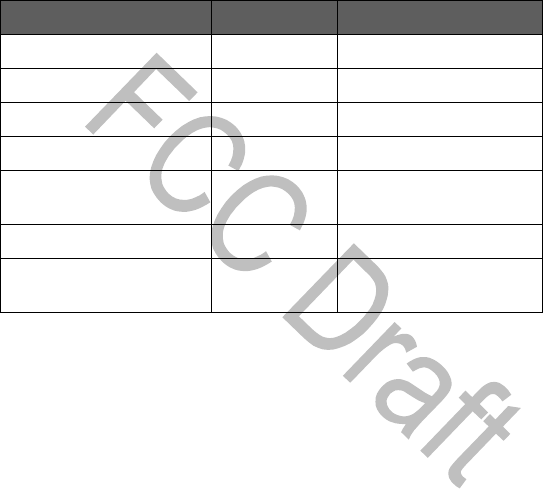
Nokia N-Gage
User Guide
What information is needed? Numbers Where is the number?
My number Wireless service provider
Voice mail number Wireless service provider
Wireless provider’s number Wireless service provider
Provider’s customer care Wireless service provider
Model number Label on back of phone (under
battery). Insert X-ref.
Phone type Back of title page
IMEI number Label on back of phone (under
battery). Insert X-ref.
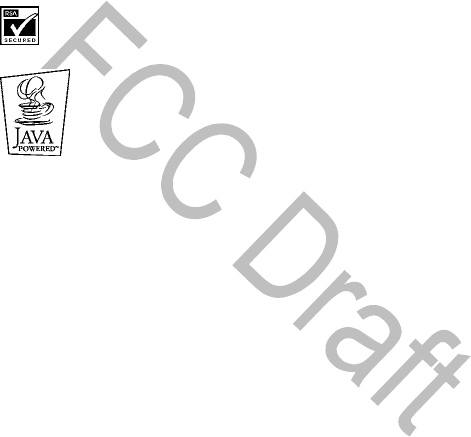
The wireless phone described in this guide is approved for use in the XXXX GSM networks in
North and South America.
LEGAL INFORMATION
Part No. 935XXXX, Issue No. 1
Copyright ©2003 Nokia. All rights reserved.
Nokia, Nokia XXXX, Triple Pop, Bounce, Pop-PortTM, Nokia Connecting People, and the Nokia
Original Enhancements logos are trademarks or registered trademarks of Nokia Corporation.
All other product and company names mentioned herein may be trademarks or tradenames
of their respective owners.
Printed in Canada 08/2003
US Patent No 5818437 and other pending patents.
T9 text input software Copyright ©1999-2002. Tegic Communications, Inc. All rights reserved.
Includes RSA BSAFE cryptographic or security protocol software from RSA Security.
Java is a trademark of Sun Microsystems, Inc.
The information in this user guide was written for the Nokia XXXX phone. Nokia operates a
policy of ongoing development. Nokia reserves the right to make changes and improvements
to any of the products described in this document without prior notice.
UNDER NO CIRCUMSTANCES SHALL NOKIA BE RESPONSIBLE FOR ANY LOSS OF DATA OR
INCOME OR ANY SPECIAL, INCIDENTAL, AND CONSEQUENTIAL OR INDIRECT DAMAGES
HOWSOEVER CAUSED.
THE CONTENTS OF THIS DOCUMENT ARE PROVIDED “AS IS.” EXCEPT AS REQUIRED BY
APPLICABLE LAW, NO WARRANTIES OF ANY KIND, EITHER EXPRESS OR IMPLIED, INCLUDING,
BUT NOT LIMITED TO, THE IMPLIED WARRANTIES OF MERCHANTABILITY AND FITNESS FOR A
PARTICULAR PURPOSE, ARE MADE IN RELATION TO THE ACCURACY AND RELIABILITY OR
CONTENTS OF THIS DOCUMENT. NOKIA RESERVES THE RIGHT TO REVISE THIS DOCUMENT OR
WITHDRAW IT AT ANY TIME WITHOUT PRIOR NOTICE.
EXPORT CONTROLS
This product contains commodities, technology or software exported from the United States in
accordance with the Export Administration regulations. Diversion contrary to U.S. law is
prohibited.
FCC/INDUSTRY CANADA NOTICE
Your phone may cause TV or radio interference (for example, when using a telephone in close
proximity to receiving equipment). The FCC or Industry Canada can require you to stop using
your telephone if such interference cannot be eliminated. If you require assistance, contact
your local service facility. This device complies with part 15 of the FCC rules. Operation is
subject to the condition that this device does not cause harmful interference.
The term “IC:” before the certification/registration number only signifies that Industry Canada
technical specifications were met.

Nokia #### User Guide Copyright © Nokia 2003
For your safety
1 For your safety
Read these simple guidelines. Breaking the rules may be dangerous or illegal.
Further detailed information is given in this manual.
Do not switch the device on when wireless phone use is prohibited or
when it may cause interference or danger.
ROAD SAFETY COMES FIRST
Obey all local laws. Always keep your hands free to operate the vehicle
while driving. Your first consideration while driving should be road
safety.
INTERFERENCE
All wireless devices may get interference, which could affect
performance.
SWITCH OFF IN HOSPITALS
Follow any regulations or rules. Switch the device off near medical
equipment.
SWITCH OFF IN AIRCRAFT
Wireless devices can cause interference in aircraft.
SWITCH OFF WHEN REFUELING
Don’t use the device at a refuelling point. Don’t use near fuel or
chemicals.
SWITCH OFF NEAR BLASTING
Don’t use the device where blasting is in progress. Observe restrictions,
and follow any regulations or rules.
USE SENSIBLY
Use only in the normal position. Don’t touch the antenna unnecessarily.
QUALIFIED SERVICE
Only qualified personnel may install or repair equipment.
ENHANCEMENTS AND BATTERIES
Use only approved enhancements and batteries. Do not connect
incompatible products.
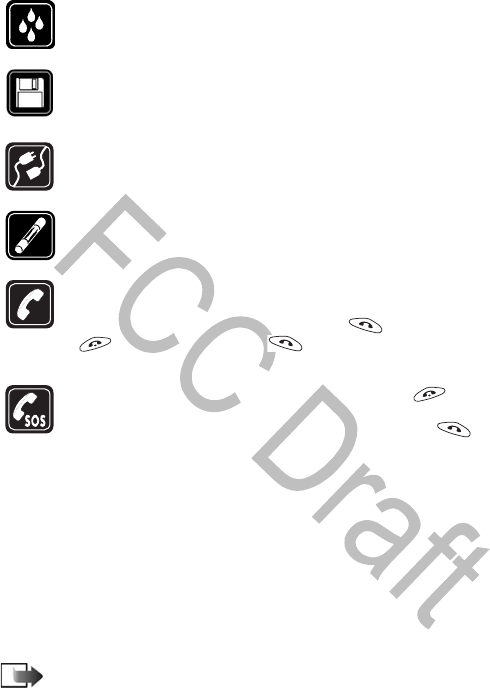
2 Copyright © Nokia 2003
WATER-RESISTANCE
Your wireless device is not water-resistant. Keep it dry.
BACKUP COPIES
Remember to make backup copies of all important data.
CONNECTING TO OTHER DEVICES
When connecting to any other device, read its user’s guide for detailed
safety instructions. Do not connect incompatible products.
FUSE REPLACEMENT
Replace a blown fuse with a fuse of the same type and size. Never use
a fuse with a higher rating!
CALLING
Ensure the device is switched on and in service. Enter the phone
number, including the area code, then press . To end a call, press
. To answer a call, press .
EMERGENCY CALLS
Ensure the device is switched on and in service. Press as many
times as needed (for example, to exit a call, to exit a menu, etc.) to
clear the display. Enter the emergency number, then press . Give
your location. Do not end the call until told to do so.
• NETWORK SERVICES
The wireless device described in this guide is approved for use on the EGSM 900
and GSM 1800 and 1900 networks.
A number of features included in this guide are called Network Services. These are
special services that you arrange through your wireless service provider. Before you
can take advantage of any of these Network Services, you must subscribe to them
through your service provider and obtain instructions for their use from your
service provider.
Note: Some networks may not support all language-dependent
characters and/or services.
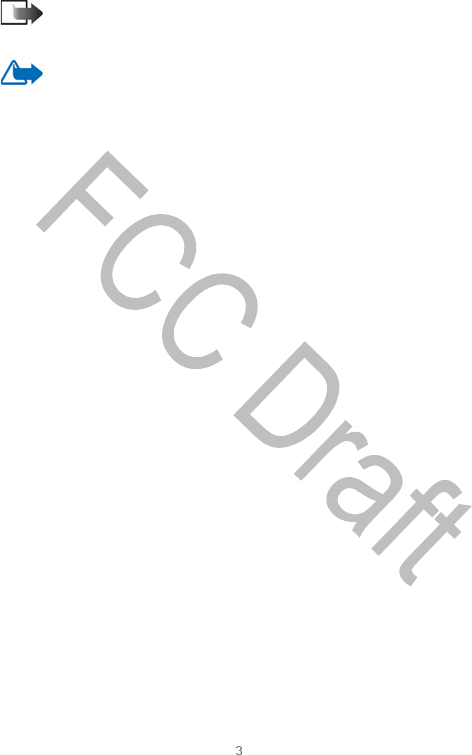
Nokia #### User Guide Copyright © Nokia 2003
For your safety
• CHARGERS AND ENHANCEMENTS
Note: Check the model number of any charger before use with this
device. This device is intended for use when supplied with power from
ACP-12, LCH-9 and LCH-12.
Warning: Use only batteries, chargers and enhancements approved by
Nokia for use with this particular device model. The use of any other types
may invalidate any approval or warranty applying to the device, and may
be dangerous.
For availability of approved enhancements, please check with your dealer.
When you disconnect the power cord of any enhancement, grasp and pull the plug,
not the cord.
When using the features in this product, honor the privacy rights of others and
obey all laws.
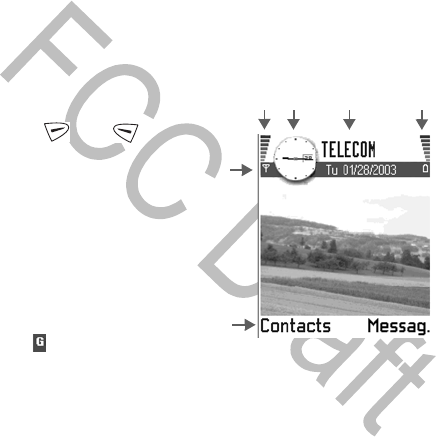
4 Copyright © Nokia 2003
2 General information
The Nokia N-Gage™ mobile game deck provides many gaming and music
capabilities in addition to common mobile features, such as the telephone features,
messaging features, a clock, an alarm clock, a calculator, calendar, and more.
•STANDBY MODE
When the device is turned on, and the screen saver is not active, the main screen
is displayed and the device is in standby mode. Typically, you return to this mode
to begin new tasks.
The indicators described in this illustration appear when the game deck is ready for
use, with no characters keyed in. The image shown in this graphic was created
specifically for this example. Your image may be different.
A The selection key bar shows the
current shortcuts assigned for the
selection keys and . To
change these shortcuts and the
background image, see “Standby mode”
on page 38.
B The navigation bar shows the currently
active profile. If the selected profile is
Normal, the current date appears instead
of a profile name. For more information,
see “Navigation bar” on page 8, and
“Profiles” on page 92.
The antenna symbol is replaced with the
GPRS symbol when the GPRS
connection is set to When available and a connection is currently available. See
“Packet data (GPRS)” on page 41, and “GPRS” on page 45.
C The signal indicator shows the signal strength of the cellular network at your
location. The higher the bar, the stronger the signal.
D The clock displays the time. To set up your clock, see “Clock” on page 104, and
settings for “Standby mode” on page 38.
E The cellular network displayed is the cellular network currently in use.
F The battery indicator shows the battery strength. The higher the bar, the more
power left in the battery.
A
B
CDEF
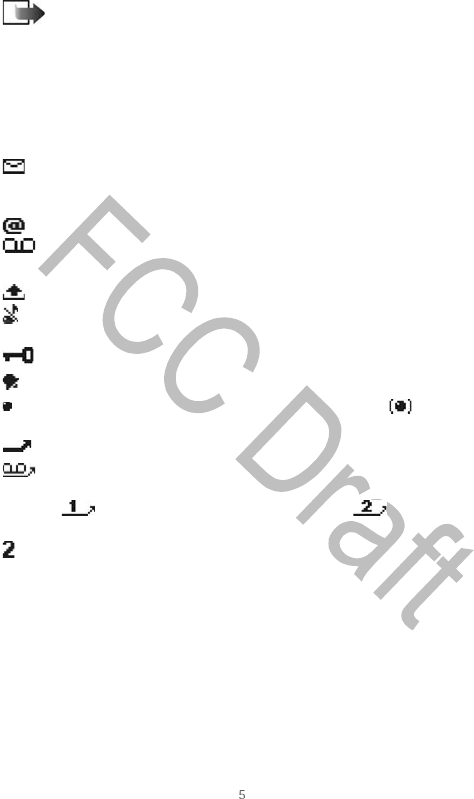
Nokia #### User Guide Copyright © Nokia 2003
General information
F Your game deck has a screen saver. If there are no actions for five
minutes, the display is cleared and a screen saver becomes visible. To
deactivate the screen saver, press any key.
• ACTION INDICATORS
One or more of the following icons may be shown when the game deck is in the
standby mode:
Indicates that you have received new messages to the Inbox in Messaging. If
the indicator is blinking, the game deck memory is low and you must delete some
data. For further information, see “Memory low” on page 127.
Indicates that you have received new e-mail (network service).
Indicates that you have received one or several voice messages. See “Call
your voice mailbox” on page 14.
Indicates that there are messages waiting to be sent in Outbox.
Shown when Incoming call alert has been set to Silent and Message alert
tone to Off in the currently active profile. See “Profiles” on page 92.
Indicates that the game deck’s keypad is locked.
Indicates that you have an active alarm. See “Clock” on page 104.
Indicates that a Bluetooth connection is active. Note that appears when
data is transmitted using a Bluetooth connection.
Indicates that all calls to the game deck are forwarded.
Indicates that all calls to the game deck are forwarded to a voice mailbox.
See “Call forwarding settings” on page 18. If you have two phone lines, this
indicator shows the call is forwarded for line 1and for line 2. See “Line
in use (network service)” on page 40.
Indicates that you can make calls using phone line 2 only (network service). See
“Line in use (network service)” on page 40.
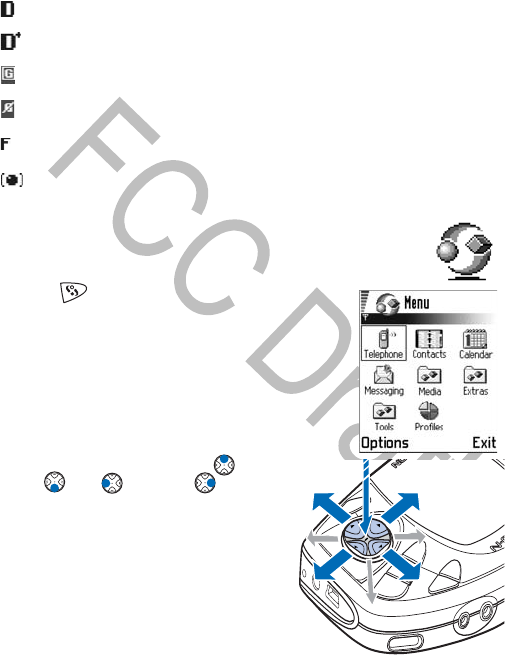
6 Copyright © Nokia 2003
Data connection indicators
When an application is establishing a data connection, one of the indicators below
blinks in the standby mode. When an indicator appears continuously, the
connection is active.
•MENU
• Press (Menu key) to open Menu (grid or list).
In the menu grid, you can access all the
applications in your game deck. Options in Menu
are Open, List view or Grid view, Move, Move to
folder, New folder, Help, and Exit.
Moving in the menu
Press the controller key on the top ,
bottom , left , and right (shown
with numbers 1, 2, 3, 4, 5) to move in the
menu grid.
You can press the controller key to move
diagonally (shown with letters a, b, c, d) i
don’t see them/cl (new graphic
coming RW)when playing games.
A data call
A high-speed data call
An active GPRS connection (replaces antenna symbol)
The GPRS connection is on hold (occurs during voice calls)
A fax call
A Bluetooth connection
need new
graphic
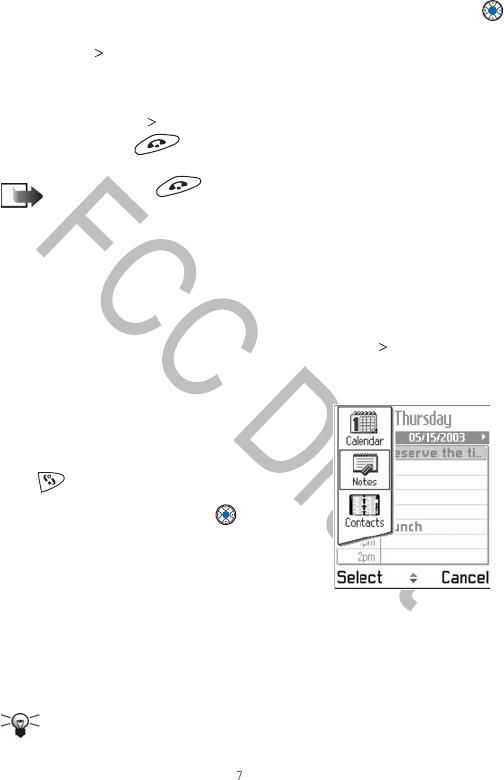
Nokia #### User Guide Copyright © Nokia 2003
General information
OPEN APPLICATIONS OR FOLDERS
Scroll to an application or a folder and press the controller key in the middle
(shown with blue arrow 5) to open it.
Select Options List view if you want to view the applications in a list.
CLOSE APPLICATIONS
Backstep by pressing Back as many times as is needed to return to the standby
mode or select Options Exit.
If you press and hold , the game deck returns to the standby mode and the
application is left open in the background.
Note: Pressing will always end a call, even if another application
is active and appears on the display.
When you switch the game deck off, applications are closed and any unsaved data
is saved automatically.
Rearrange the menu
You can rearrange the menu in any order you like. You can move applications that
you use more often from a folder to the menu grid. You can also create new folders.
1Scroll to the item you want to move and select Options Move.
A check mark is placed beside the application.
2Move the selection where you want the application to be and press OK.
Switch between applications
If you have several applications open and want to
switch from one application to another, press and
hold (menu key). The application switching
window opens and shows a list of open applications.
Scroll to an application and press to select it.
If memory is low, the game deck may close some
applications. The game deck saves unsaved data
before an application closes.
•OPTIONS LISTS
This guide provides the options list commands on the side of the page. These lists
tell you which commands are available in different views and situations as the
available commands change depending on the selected view.
Tip: In some situations, when you press the controller key, a shorter
options list appears, listing the main commands available.
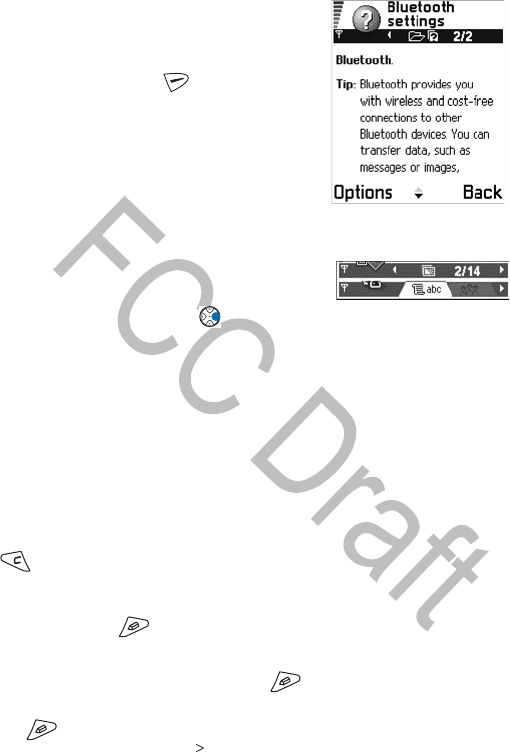
8 Copyright © Nokia 2003
•ONLINE HELP
Your Nokia N-Gage game deck has an online help
that you can access from any application that has
an Options list. Press the key to open the
Options list.
• NAVIGATION BAR
In the navigation bar, the following information
and indicators appear:
• Small arrows or tabs that tell you if there are
more views, folders, or files you can move to
• Editing indicators. See “Write text” on page 68
• Other information, for example, 2/14 means
that the current picture is the second of 14
pictures in the folder. Press to see the next
picture.
• APPLICATION ACTIONS
Open items for viewing—When you are viewing a list of files or folders, to open
an item, scroll to an item and press the controller key or select Options > Open.
Edit items—To open an item for editing, you sometimes need to first open it for
viewing and then select Options > Edit, if you want to change its contents.
Rename items—To give a new name to a file or folder, scroll to it and select
Options > Rename.
Remove, delete items—Scroll to the item and select Options > Delete, or press
. To delete many items at a time, you first need to mark them.
Mark an item—There are several ways to select items in a list.
• To select one item at a time, scroll to it and select Options > Mark/Unmark >
Mark or press and the controller key at the same time. A check mark is
placed next to the item.
• To select all items in the list, select Options > Mark/Unmark > Mark all.
• To mark multiple items, press and hold while moving the controller key
up or down. As the selection moves, a check mark is placed next to the items.
To end the selection, stop the scrolling with the controller key and then release
. After you have selected all the items you want, you can move or delete
them by selecting Options Move to folder or Delete.
To unmark an item, scroll to it and select Options > Mark/Unmark > Unmark
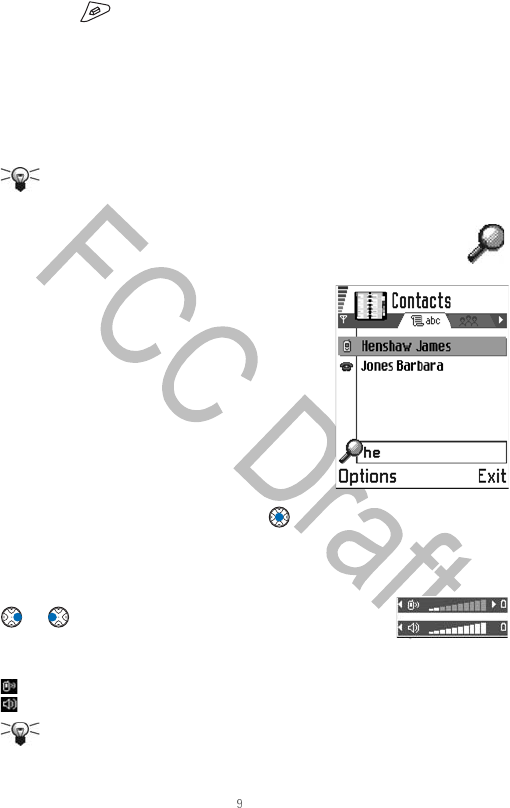
Nokia #### User Guide Copyright © Nokia 2003
General information
or press and the controller key at the same time.
Create folders—To create a new folder, select Options > New folder. You are asked
to give a name to the folder (max. 35 letters).
Move items to a folder—To move items to a folder or between folders, select
Options > Move to folder (not shown if there are no folders available). When you
select Move to folder, a list of available folders opens and you can also see the root
level of the application (for moving an item out of a folder). Select the new location
you want the item to be moved to and press OK.
Tip: For information on how to insert text and numbers, see “Write text”
on page 68.
• SEARCH FUNCTION
You can search for a name, file, folder, or shortcut by
using the search field. In some situations the search
field is not visible automatically, but you can
activate it by selecting Options > Find or just by
entering letters.
1To search for an item, start to key in text in the
search field.
The game deck immediately starts to search for
matches and moves the selection on the best
match.
2To make the search more accurate, key in more
letters and the selection moves to the item that
best matches the letters.
3When the correct item is found, press to open it.
•VOLUME CONTROL
When you have an active call or are listening to a sound, press
or to increase or decrease the volume level,
respectively.
The following icons indicate voice volume mode:
Earpiece mode
For loudspeaker mode
Tip: Using the supplied headset is a fun way to use the game deck for
calls, games or listening to music.
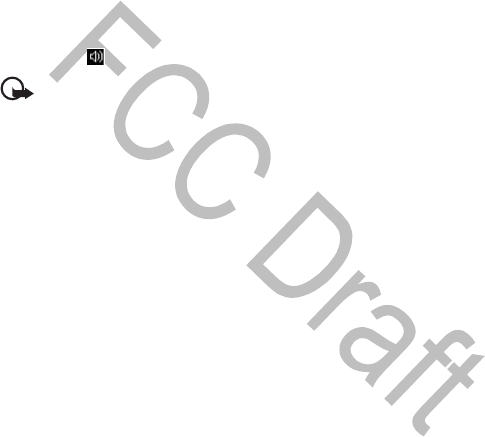
10 Copyright © Nokia 2003
•LOUDSPEAKER
Your game deck has a loudspeaker for hands-free use. To locate the loudspeaker,
see the picture of the different keys and parts in the Quick Start guide. The
loudspeaker allows you to speak and listen to the game deck from a short distance
(such as on a nearby table) without having to hold the game deck to your ear. The
loudspeaker can be used during a call, with sound applications, and when viewing
multimedia messages. RealOne Player™ uses the loudspeaker by default when you
watch a video. Using the loudspeaker makes it easier to use other applications
while in a call.
Activate the loudspeaker
To use the loudspeaker during an active call, select Options > Activate loudsp. A
tone is played, appears in the navigation bar, and the volume indicator changes.
Important: Do not hold the game deck near your ear when the
loudspeaker is in use as the volume may be extremely loud.
The loudspeaker needs to be activated separately each time for phone calls, but the
sound applications such as Composer and Recorder use the loudspeaker by default.
Turn off the loudspeaker
When you have an active call or music is playing, select Options > Activate
handset.
Attach and use the headset
A stereo headset is supplied for using with your phone. In addition to using the
headset for calls, you can also use it to listen to the FM radio or the music player
in your game deck. The headset wire is the FM radio antenna.
If you use a different headset, it must be compatible for the FM radio to function
properly. To make a call with a headset on, use the keypad. Once the call is
established you can use the headset to speak and listen to the other party.
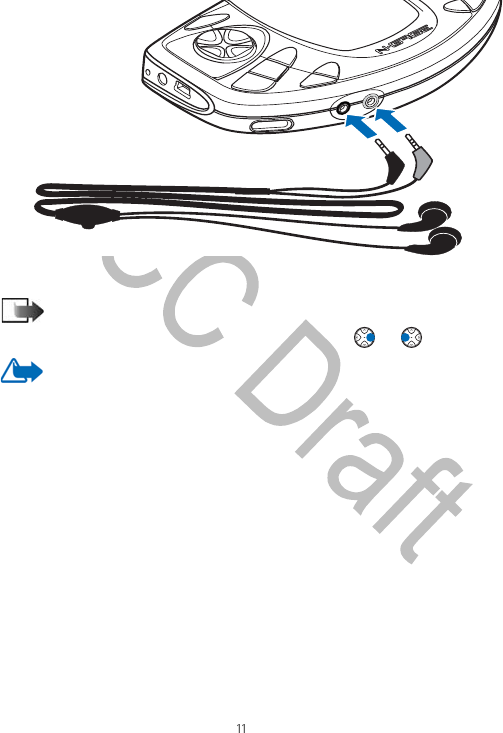
Nokia #### User Guide Copyright © Nokia 2003
General information
Connect the headset
Insert the black headset cable mini-plug (1) into the connector on the game deck,
and insert the grey headset cable mini-plug (2) into the connector.
The headset lead functions as the antenna of the radio, so let it hang freely.
Note: Listen to music at a moderate level. Continuous exposure to high
volume may damage your hearing. To adjust the volume level when a
headset is connected to your game deck, press or .
Warning: When using a stereo headset your ability to hear outside
sounds is reduced. Do not use a headset where it can endanger your
safety.
Use the headset to receive calls
To answer a call while using the headset, press the remote control button (3) which
is located in the microphone part of the headset. To end the call, press the same
button.
• ATTACH AND USE SUPPLIED CABLES
With the sales package, you receive two cables that you can use with your game
deck.
You can use the Nokia Audio Manager to store and organize your sound files. For
more information, see “Nokia Audio Manager” on page 32.
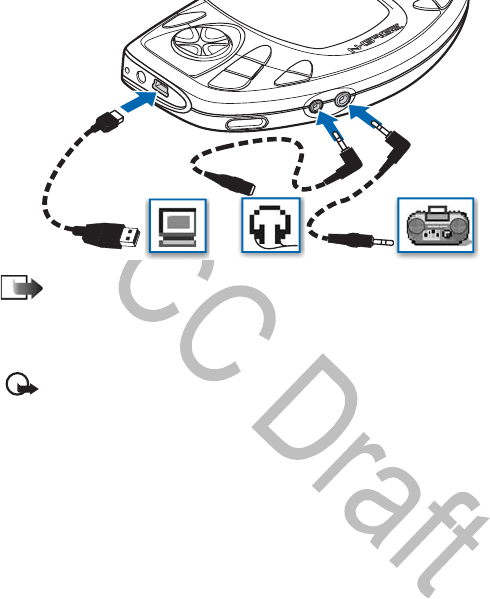
12 Copyright © Nokia 2003
1To connect your game deck to a compatible external audio system (for
example, CD player), use the supplied ADE-2 audio line-in cable (3).
Note: Recording should be monitored from the headset socket on the
external device. Adjust the volume on the external device so that there is
no distortion.
2To attach the game deck to a compatible PC, use the supplied DKE-2 USB
mini-B cable (1).
Important: Install the Nokia Audio Manager PC software from the
CD-ROM to your PC before connecting the supplied DKE-2 USB mini-B
cable.
3To connect your game deck to your own headphones, use the supplied ADA-2
adapter cable (2).
• SHARED MEMORY
The following features in this device may share memory: games, contacts, text
messages, multimedia messages, images and ringing tones, RealOne Player™,
calendar and to-do notes, and downloaded applications. Using one or more of
these features may reduce the memory available for the remaining features sharing
memory. For example, saving many multimedia messages may use all of the
available memory. Your phone may display a message that the memory is full when
you try to use a shared memory feature. In this case, delete some of the information
or entries stored in shared memory features before continuing. Some of the
features, such as contacts, may have a certain amount of memory specifically
allotted to them in addition to the amount of memory shared with other features.

Nokia #### User Guide Copyright © Nokia 2003
General information
Note: Music tracks are stored on the memory card and therefore do not
use the shared memory of the game deck.
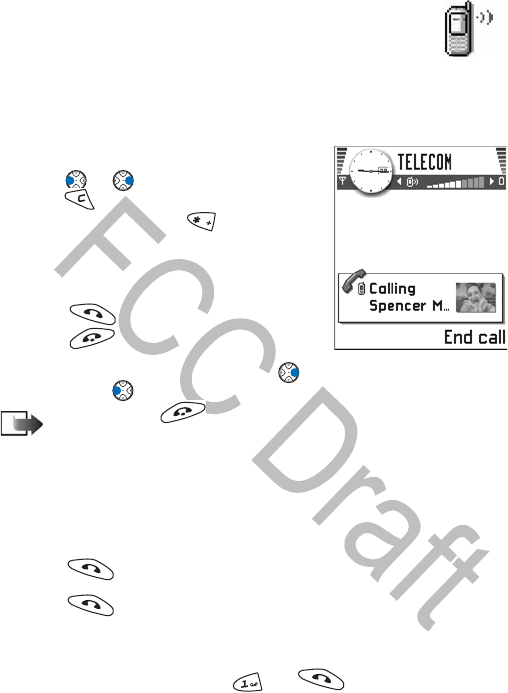
14 Copyright © Nokia 2003
3 Using your game deck as
a phone
• MAKE A CALL
1In the standby mode, key in the phone number,
including the area code.
2Press or to move the cursor.
Press to remove a number.
For international calls, press twice for the
international prefix (the + character replaces the
international access code) and then key in the
country code, the area code without 0, and the
phone number.
1Press to call the number.
2Press to end the call (or to cancel the
call attempt).
To adjust the volume during a call, press to
increase and to decrease the volume level.
Note: Pressing always ends a call, even if another application
is active.
The Contacts directory
1To open the Contacts directory, press Contacts.
2To find a contact, scroll to the desired name, or key in the first letters of the
name.
The Search field opens automatically and matching contacts are listed.
3Press to start the call.
4If the contact has more than one phone number, scroll to the number and
press to start the call.
Call your voice mailbox
The voice mailbox (network service) lets callers leave voice messages.
• To call your voice mailbox, press and in the standby mode.
• If the game deck asks for the voice mailbox number, key it in and press OK.
You can obtain this number from your service provider.
See also “Call forwarding settings” on page 18.
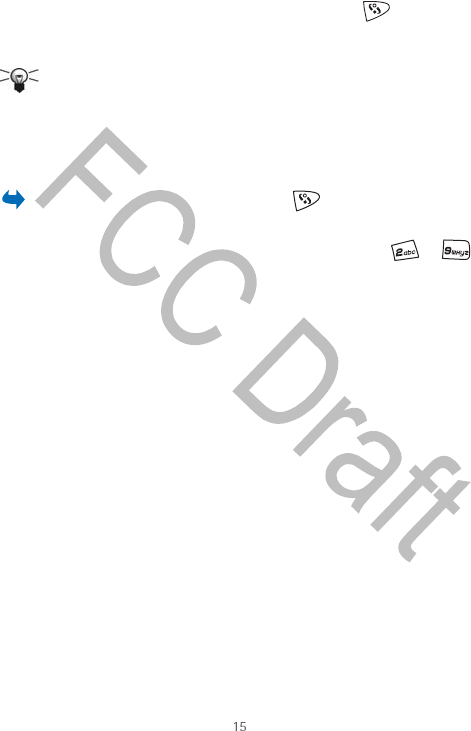
Nokia #### User Guide Copyright © Nokia 2003
Using your game deck as a phone
Each phone line may have its own voice mailbox number. See “Line in use (network
service)” on page 40.
Change the voice mailbox number
To change the phone number of your voice mailbox, press and go to Tools >
Voice mailbox and select Options > Change number. Key in the number (obtained
from your service provider) and press OK.
Tip: If your voice mail requires a password, you may want to add a touch
tone number after the voice mailbox number. This way the password is
given automatically every time you call your voice mail. For example,
+555123 4567p1234#. The letter ‘p’ inserts a pause and 1234 is the
password.
1-touch dialing
To view the 1-touch dialing grid, press and go to Tools > 1-touch
dial (is this speed dialing-will gui change?/cl).
1Assign a phone number to one of the 1-touch dialing keys ( to ). See
“Assign 1-touch dialing keys” on page 55.
2Set the 1-touch dialing function to On.
3To call the number: In the standby mode, press and hold the corresponding 1-
touch dialing key until the call is started.
Make a conference call
Conference calling is a network service that allows you to make a conference call
with up to six participants, including yourself.
1Make a call to the first participant.
2To make a call to a second participant, select Options >New call.
3Key in or search the memory for the phone number of the participant and press
OK.
The first call is automatically put on hold.
4When the second call has been answered, join the first participant in the
conference call by selecting Options >Conference.
5To add a new person to the call, select Options >New call, and then select
Options > Conference > Add to conference.
6Key in or search the memory for the phone number of the participant and press
OK.
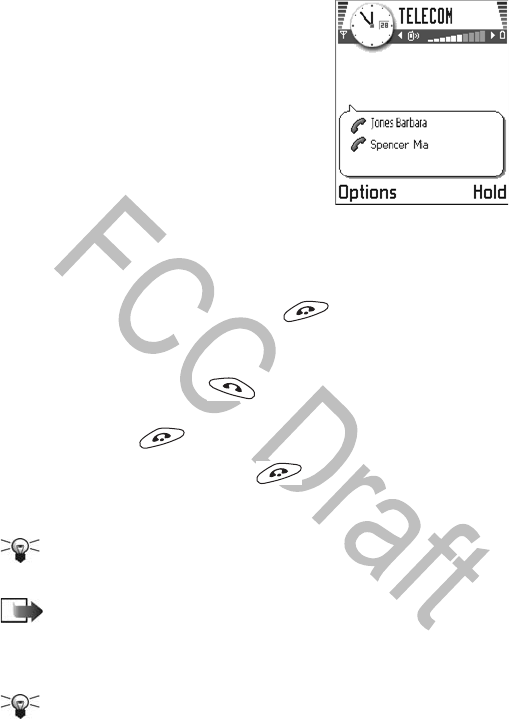
16 Copyright © Nokia 2003
To have a private conversation with one of the
participants, perform the following steps:
1 Select Options > Conference > Private.
2Scroll to the desired participant and press
Private.
The conference call is put on hold in your game
deck, and the other participants can still
continue talking with each other while you
have a private discussion with one participant
only.
3Once you have finished the private
conversation, select Options > Add to conference to return to the conference
call.
4To drop one participant from the conference call, select Options >
Conference > Drop participant, scroll to the participant, and press Drop.
5To end the active conference call, press .
• ANSWER A CALL
To answer an incoming call, press , or if you are using the supplied headset
press the remote control button.
To end the call, press , or if you are using the supplied headset, press the
remote control button.
If you do not want to answer a call, press . The caller will hear a “line busy”
tone.
When a call comes in, press Mute to quickly mute the ringing tone.
Tip: To adjust the game deck tones for different environments and events,
for example, when you want your game deck to be silent, see “Profiles” on
page 92.
Note: It is possible that the game deck may assign a wrong name for the
phone number. This happens if the phone number of the caller is not
stored in Contacts but the seven last digits of the number match another
number that is stored in Contacts. In this case, call identification is not
correct.
Tip: To end all calls at the same time, select Options > End all calls and
press OK.
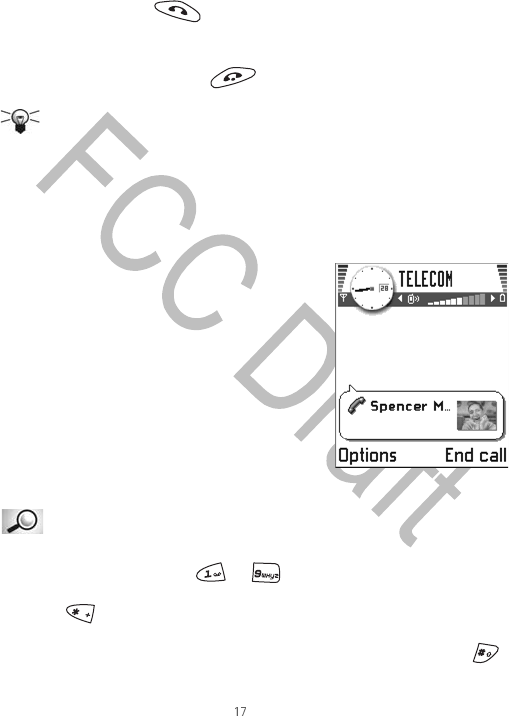
Nokia #### User Guide Copyright © Nokia 2003
Using your game deck as a phone
Call waiting
If you have activated the call waiting network service, the network will notify you
of a new incoming call while you have a call in progress. See “Call waiting” on
page 39.
1During a call, press to answer the waiting call.
The first call is put on hold.
2To switch between the two calls, press Swap.
3To end the active call, press .
Tip: If you have activated the Call forwarding > If busy function to
forward calls, for example, to your voice mailbox, rejecting an incoming
call also forwards the call. See “Call forwarding settings” on page 18.
Options during a call
Your game deck includes a comprehensive list of menu options that are available
for handling phone calls. Some options apply only to specific network services that
you may or may not have active, such as conference calling.
Press Options during a call for some of the following
options:
Mute or Unmute, End active call, End all calls, Hold
or Unhold, New call, Conference, Private, Drop
participant, Answer, and Decline.
Swap is used to switch between the active call and
the call on hold.
Transfer is used to connect an incoming call or a call
on hold with an active call and to disconnect
yourself from both calls.
Send touch tone is used to send DTMF tone strings,
for example, passwords or bank account numbers.
Glossary: DTMF tones are the tones you hear when you press the number
keys on the game deck keypad. DTMF tones allow you to communicate
with voice mailboxes and computerized telephony systems, for example:
1Key in the digits with keys to .
Each keystroke generates a DTMF tone that is transmitted during the call.
Press repeatedly to produce *, p which inserts a pause of about two
seconds before or between DTMF characters, and w which causes the
remaining sequence to wait until you press Send during the call. Press
to produce #.
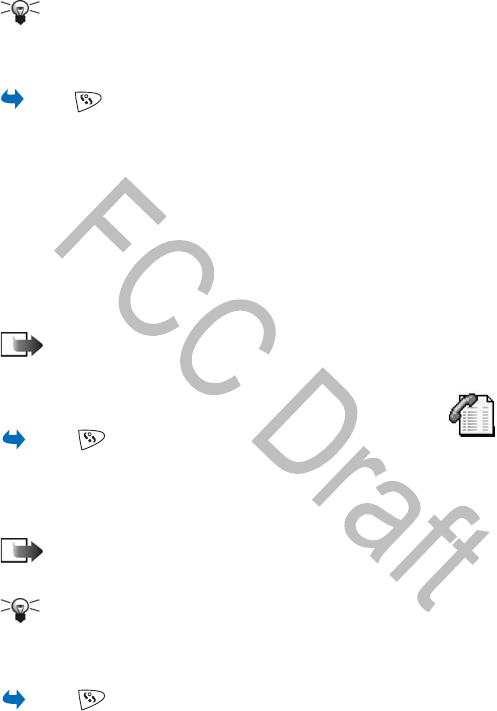
18 Copyright © Nokia 2003
2To send the tone, press OK.
Tip: You can also store a sequence of touch tones for a contact card.
When you make a call to the contact, you can retrieve the sequence. Add
DTMF tones to the phone number or DTMF fields in a contact card.
Call forwarding settings
Press and go to Tools > Call forwarding.
When this network service is activated, you can direct your incoming calls to
another number, for example, to your voice mailbox number. For details, contact
your service provider.
• Select one of the forwarding options. For example, select If busy to forward
voice calls when your number is busy or when you decline incoming calls.
•Select Options > Activate to set the forward setting on, Cancel to set the
forward setting off, or Check status to check whether forwarding is activated
or not.
• To cancel all active forwarding, select Options > Cancel all forwarding.
For information about the call forwarding indicators, see “Action indicators” on
page 5.
Note: You cannot restrict incoming calls and have call forwarding active
at the same time. See “Call restrictions” on page 49.
• CALLS, call log, AND GENERAL LOG
Press and go to Extras > Log.
In Log you can monitor phone calls, text messages, packet data connections, and
fax and data calls registered by the game deck. You can filter the general log to
view just one type of event, such as text messages, and create new contact cards
based on the log information.
Note: Connections to your remote mailbox, multimedia messaging
center, or browser pages are shown as data calls or packet data
connections in the general communications log.
Tip: To view a list of sent messages, go to the main menu and press
Messaging > Sent.
Recent calls register
Press and go to Extra > Log > Recent calls.
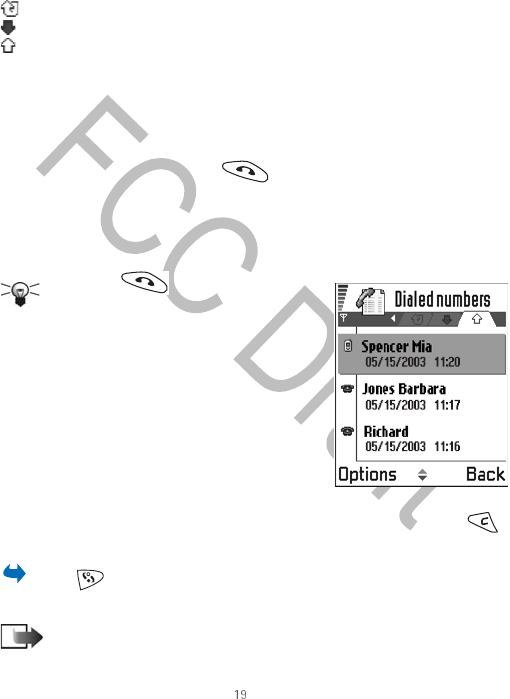
Nokia #### User Guide Copyright © Nokia 2003
Using your game deck as a phone
The game deck registers the phone numbers of missed, received, and dialed calls,
and the approximate duration and cost of your calls. The game deck registers
missed and received calls only if the network supports these functions, and the
game deck is switched on and within the network’s service area.
Call icons are as follows:
Missed calls
Received calls
Dialed numbers
Options in the Missed calls, Received calls, Dialed numbers views are Call, Use
number, Delete, Clear list, Add to Contacts, Help, and Exit.
MISSED AND RECEIVED CALLS
If you miss a call, a note appears in the display. Press Show to see the number. If
you have missed more than one call, the numbers are listed. To return a call, scroll
to the number you want and press , or press Exit to return to standby.
To view a list of the last 20 missed calls, go to Log > Recent calls > Missed calls.
To view a list of the last 20 accepted calls (network service), go to Log > Recent
calls > Received calls.
DIALED NUMBERS
Tip: Press in the standby mode to
open the Dialed numbers view.
To view the 20 phone numbers that you have most
recently called or attempted to call, go to Log >
Recent calls > Dialed nos..
ERASE RECENT CALL LISTS
• To clear all recent call lists, select Options >
Clear recent calls in the Recent calls main
view.
• To clear one of the call registers, open the
register you want to erase and select Options >
Clear list.
• To clear an individual call, open a register, scroll to the call, and press .
Call duration
Press and go to Extras > Log > Call duration.
Allows you to view the duration of your incoming and outgoing calls.
Note: The actual time invoiced for calls by your service provider may vary,
depending upon network features, rounding-off for billing, and so forth.
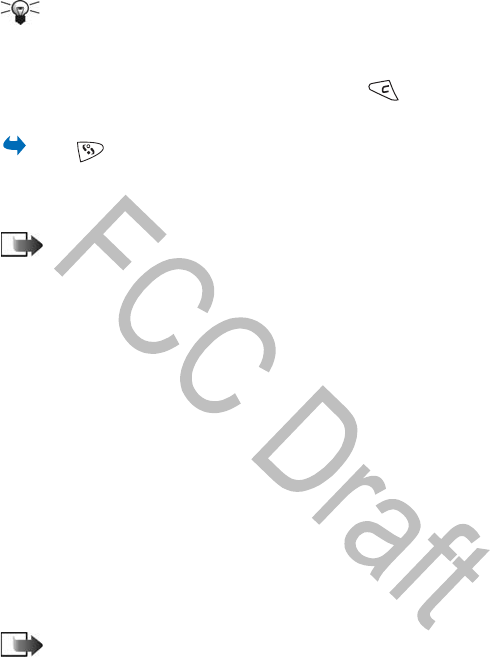
20 Copyright © Nokia 2003
Tip: To see the call duration timer during an active call, select Options >
Settings > Show call duration > Yes.
ERASE CALL DURATION TIMERS
Select Options > Clear timers. For this you need the lock code. See “Security” on
page 46. To clear an individual event, scroll to it and press .
Call costs
Press and go to Extras > Log > Call costs.
The call cost features only apply if your service provider is providing call cost
services. If you have this option activated, you can check the cost of the last call
or all calls. The call costs are displayed separately for each SIM card.
Note: The actual invoice for calls and services from your service provider
may vary, depending upon network features, rounding-off for billing,
taxes and so forth.
CALL COSTS LIMIT
Your service provider can limit your calls to a certain amount of charging units or
units of currency. When the limited charging mode is active, calls can be made only
as long as the preset credit limit (call cost limit) is not exceeded and you are in a
network that supports call cost limit. The number of remaining units appears
during a call and in the standby mode. When the charging units have expired, Call
cost limit reached appears. Contact your service provider for information on the
limited charging mode and charging unit prices.
CHARGING UNITS OR CURRENCY
You can set the game deck to show the remaining talk-time in charging units or
units of currency. For this, you may need the PIN2 code. See page 46.
1Select Options > Settings > Show costs in.
The options are Currency and Units. If you choose Currency, a note requesting
you to write the unit price appears.
2Key in the cost of your home network charging or credit unit and press OK.
3Write a name for the currency. Use a three-letter abbreviation, for example,
EUR.
Note: When no more charging units or currency units are left, calls may
only be possible to the emergency number programmed into your game
deck (for example, 911).
SET A LIMIT
1Select Options > Settings > Call cost limit > On.
The game deck requests you to enter the limit in units. For this you may need
the PIN2 code.
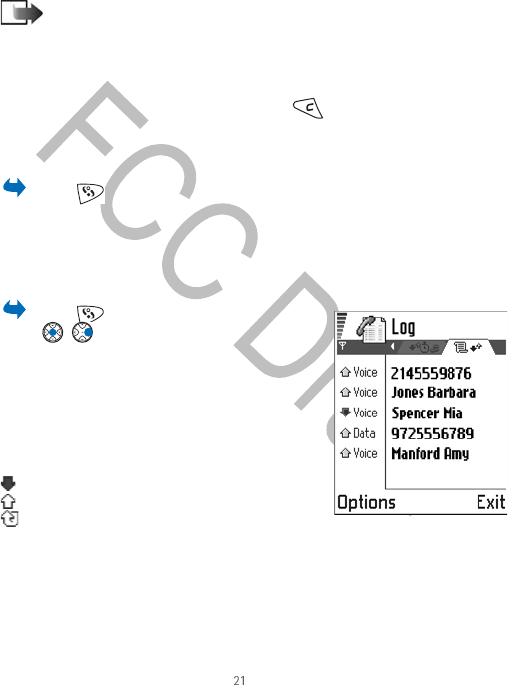
Nokia #### User Guide Copyright © Nokia 2003
Using your game deck as a phone
2Depending on the Show costs in setting, enter either the amount of charging
units or currency.
When the charging limit you have set is reached, the counter stops at its maximum
value and Reset all calls’ cost counter appears. To be able to make calls, go to
Options > Settings > Call cost limit > Off. For this you need the PIN2 code, see
page 46.
The actual invoice for calls and services from your service provider may
vary, depending upon network features, rounding off for billing, taxes,
and so forth.
ERASE COUNTERS
Select Options > Clear counters. For this you need the PIN2 code. See page 46. To
clear an individual event, scroll to it and press .
• GPRS DATA COUNTER
Press and go to Extras > Log > GPRS counter.
The data counter allows you to check the amount of data sent and received during
packet data (GPRS) connections. This might be useful if you are charged for your
GPRS connections by the amount of data sent and received.
View the general call log
Press , go to Extras > Log,
press .
In the general log, for each call or message received,
you can see the sender or recipient name, phone
number, name of the service provider, or access
point. Text messages sent in more than one part or
by packet data connections are shown as one entry
The call log icons are as follows:
Incoming
Outgoing
Missed calls or messages
FILTER THE LOG
1Select Options > Filter. A list of filters opens.
2Scroll to a filter and press Select.
ERASE THE LOG
To erase all the Log contents, Recent calls register, and Messaging delivery reports,
select Options > Clear log. Press OK to confirm.
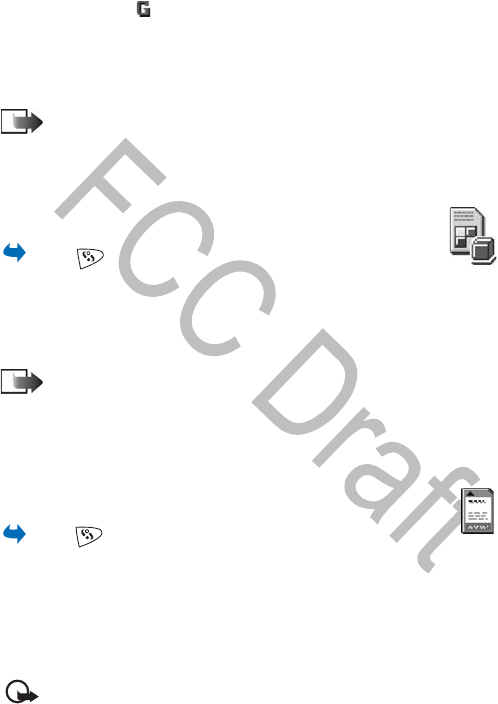
22 Copyright © Nokia 2003
PACKET DATA COUNTER AND CONNECTION TIMER
To view how much data, measured in kilobytes, has been transferred and how long
a certain GPRS connection has lasted, scroll to an incoming or outgoing event with
the access point icon and select Options > View details.
CALLS SETTINGS
•Select Options > Settings. The list of settings opens.
• The log events remain in the game deck memory for a limited number of days
(Log duration) and then are automatically erased. This helps free memory.
Note: If you select No log, all the log contents, recent calls register, and
messaging delivery reports are permanently deleted.
•For Call duration, Show costs in, Call cost limit, see the sections “Call
duration” on page 19, and “Call costs” on page 20.
•SIM FOLDER
Press and go to Tools > SIM.
Your SIM card may provide additional services that you can access in this folder.
Check with your service provider for details.
Options in the SIM directory are Open, Call, New SIM contact, Edit, Delete,
Copy to Contacts, My numbers, SIM details, Help, and Exit.
Note: For availability, rates, and information on using SIM services,
contact your SIM card vendor, network operator, service provider, or other
vendor.
• In the SIM directory, you can see the names and numbers stored on the SIM
card, you can add or edit them, and you can make calls.
• MEMORY CARD
Press and go to Tools > Memory card. (UI says Memory/
cl)
If you have a memory card you can use it to store your games, music tracks,
multimedia files like video clips and sound files, images, and messaging
information. You can also back up information from your game deck memory
Details on using the memory card with other features and applications of your
game deck are given in the sections describing these features and applications.
Important: Keep all memory cards out of the reach of small children.
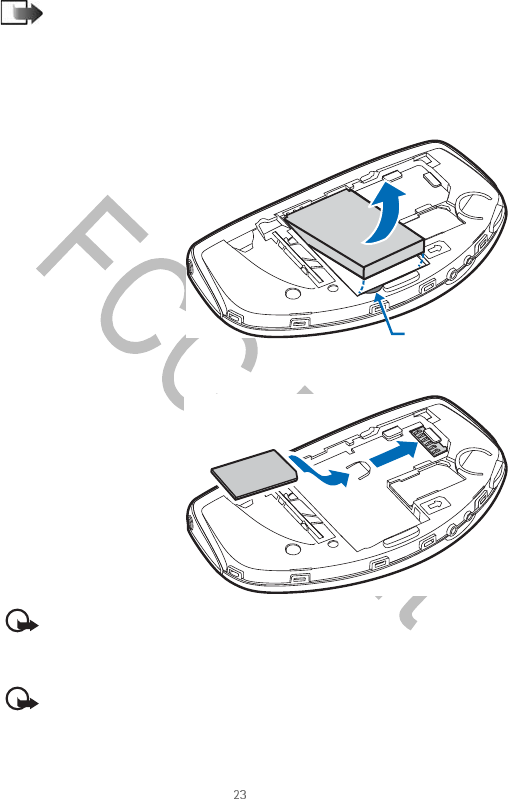
Nokia #### User Guide Copyright © Nokia 2003
Using your game deck as a phone
Note: Use only memory cards that are compatible with your game deck.
Data stored on a memory card using another device may be corrupted
when you try to use it on the game deck.
Options in the memory card are Backup device mem., Restore from card,
Format mem. card, Memory card name, Set password, Change password,
Remove password, Unlock memory card, Mem. in use, Help, and Exit.
Insert the
memory card
1Make sure the game
deck is switched off.
2With the back of the
game deck facing you,
slide open the cover,
put your finger in the
slot, then lift the
battery.
(See “Insert the SIM
card” in the Quick
Start guide for instructions on removing the cover.)
3Remove the existing
memory card (if
installed).
4Position the memory
card in its slot with
the gold contacts of
the card facing down.
5When you have
secured the card in
place, replace the
battery and replace
the cover.
Important: Do
not remove the memory card in middle of an operation. Be sure to close
all memory card applications and turn the game deck off before removing
the card.
Important: If you are installing an application to the memory card and
need to restart the game deck, do not remove the card until the restart is
complete. Otherwise the application files may be lost.
Battery slot
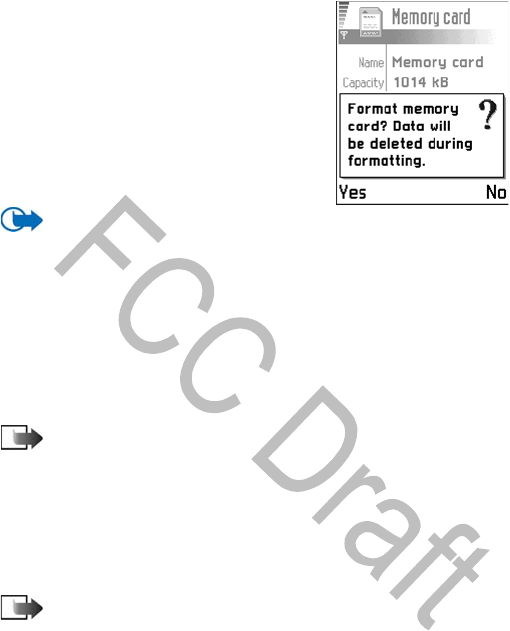
24 Copyright © Nokia 2003
Format the memory card
The memory card must be formatted before its first
use. If it is not preformatted, format the card using
these steps.
1Select Options > Format mem. card.
2Confirm your request.
After you confirm, formatting starts.
Important: When a memory card is
formatted all data on the card is permanently lost.
Back up and restore information
To backup information from your game deck memory to the memory card, select
Options > Backup device mem.
To restore information from the memory card to the game deck’s memory, select
Options > Restore from card.
Password
You can set a password to lock your memory card against unauthorized use.
Note: The password is stored in your game deck and you do not have to
enter it again while you are using the memory card on the same game
deck. If you want to use the memory card on another game deck, you will
be asked for the password.
SET, CHANGE, OR REMOVE YOUR PASSWORD
Select Options > Set password, Change password, or Remove password.
For every option, you will be asked to enter and confirm your password. The
password can be up to eight characters long.
Note: Once the password is removed, the memory card is unlocked and
can be used on another game deck without a password.
Unlock a memory card
If you insert another password protected memory card in your game deck, you will
be prompted to enter the password of the card. To unlock the card, select Options
> Unlock memory card.

Nokia #### User Guide Copyright © Nokia 2003
Using your game deck as a phone
Check memory consumption
Using the Mem. in use option, you can check the memory consumption of different
data groups and the available memory for installing new applications or software
on your memory card. To check memory consumption, select Options > Mem. in
use.
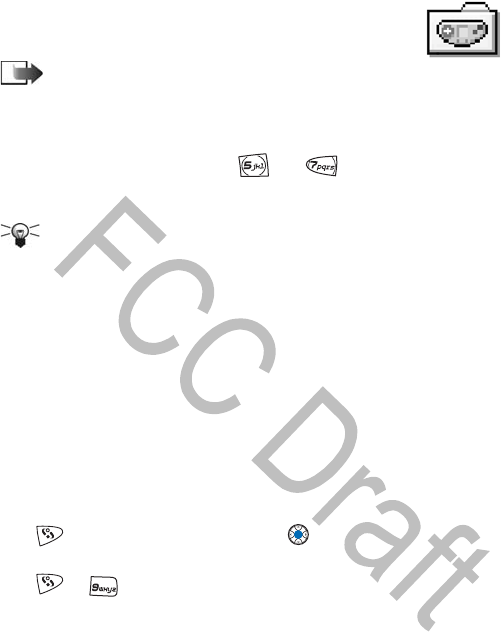
26 Copyright © Nokia 2003
4Games
Note: Your game deck must be switched on to use this
function. Do not switch the game deck on when wireless device use is
prohibited or when it may cause interference or danger.
The performance of games may be reduced if you have many applications open.
Therefore, close other applications before playing games.
You can use the primary games keys, and , for playing games. Other
keys may be used depending on the game. Refer to the instructions supplied with
the game for further information.
Tip: You can answer and end a call while continuing to play a game.
Playing games consumes power and the game deck operating time is reduced. The
music player is not accessible when playing games.
You can purchase a variety of games for your game deck. For availability of
different games, contact your local retailer or visit www.n-gage.com.
• START A GAME
Each game is supplied on a separate memory card. Insert the memory card of the
game into the Nokia N-Gage game deck. See “Memory card” on page 22. The game
icon automatically appears on the display screen.
Refer to the playing instructions supplied with the game for further information.
Also, you can play Java games that you have downloaded from the Internet. See
“Install a Java application” on page 114 .
Press , scroll to the game icon and press .
OR
Press > to start the game.
Start a two-player game
You may play a two-player game using a Bluetooth connection with a friend who
has the same game on a compatible device. Before starting a two-player game,
ensure that the Bluetooth connection settings of the devices are compatible. See
“Bluetooth WIRELESS connection” on page 119 . Refer to the instructions supplied
with the game for details of how to start the game, different levels and additional
features etc.

Nokia #### User Guide Copyright © Nokia 2003
Games
Start a multiplayer game
You may play some games with multiple players using Bluetooth connections with
friends who have the same game on a compatible device. Before starting a
multiplayer game, ensure that the Bluetooth settings of the devices are compatible.
See “Bluetooth WIRELESS connection” on page 11 9. Refer to the instructions
supplied with the game for details on how to start the game, different levels, and
additional features.
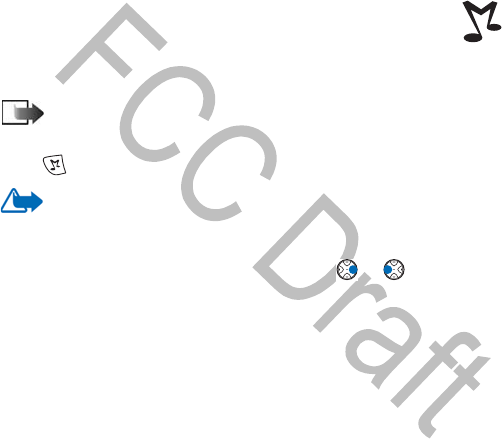
28 Copyright © Nokia 2003
5 Music player and radio
You can listen to music saved on the memory card or the radio with your game
deck. You can also record music from the radio or an external music source. You
can record or transfer music tracks of near CD-quality to your memory card.
The memory card can only display the details of the first 255 music tracks.
To transfer music tracks from a compatible PC to the game deck, see “Nokia Audio
Manager” on page 32.
• MUSIC PLAYER
With the Music Player, you can listen to music tracks stored in the
memory card. To listen, attach the headset to the game deck, or listen through the
loudspeaker.
Note: Your game deck must be switched on to use this function. Do not
switch the game deck on when wireless device use is prohibited or when
it may cause interference or danger.
Press to turn on the music player.
Warning: Listen to music at a moderate level. Continuous exposure to
high volume may damage your hearing.
Once you have turned the music player on, it starts playing tracks. To adjust the
volume level of the headset or the loudspeaker, press or to increase or
decrease the volume level.
Music can only be played from a 16-MB, 64-MB or 128-MB memory card.
Using the music player consumes additional power, and the game deck operating
time is reduced.
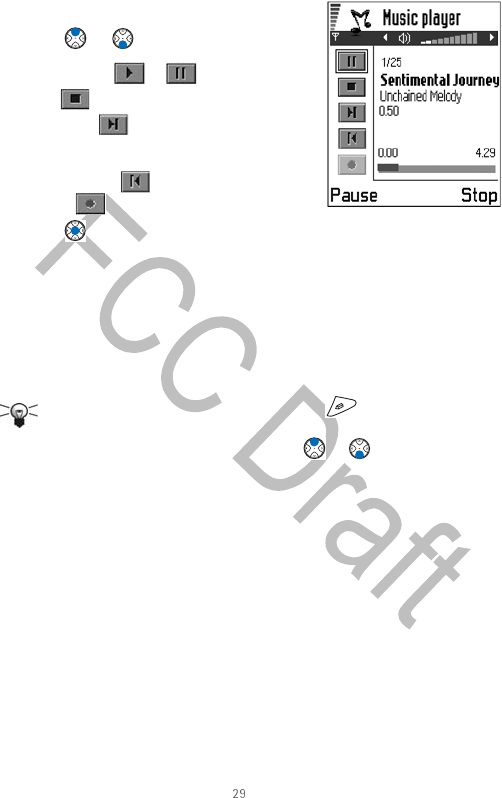
Nokia #### User Guide Copyright © Nokia 2003
Music player and radio
Listen to music
1Press or to highlight the control
button:
Play or pause or (toggles)
Stop
Next track
You can also press the headset button to
select the next track.
Previous track
Record
2Press to select.
Options in Music Player are Track list, Settings, Activate loudsp. /Deactivate
loudsp., Help, and Exit.
In the Track list you can view and play the music tracks that you have stored in
your game deck.
Options in Track list are Play, Delete, Rename, Select, Unselect, Help, and Exit. An
unselected track remains in the track list but cannot be played.
To view stored music tracks, press Options > Track list.
Tip: When listening to music you can press to display available
options.
To play one of the music tracks in Track list, press or to highlight the track
and then press Options > Play.
To answer and make calls while listening to the music player. During a call, the
track is paused and the music player is muted. When you end the call, the music
player will automatically resume.
To answer an incoming call while using the headset, press the headset button. The
music player is paused when the game deck rings. To end the call, press the headset
button again. See “Attach and use the headset” on page 10 for more information.
To edit the settings, press Options and select Settings. The following options are
available:
Sound style—You can select the style of the music tracks you play in order to
automatically set equalizer options and enhance playback quality. Bass and Treble
levels. Balance become available according to the selected style: Rock, Pop, Dance,
Jazz, Classic, Latin, and Normal.
Play options—Select Normal to play the tracks stored in your game deck in the
order in which they appear in the track list. You can also select Random or Repeat.
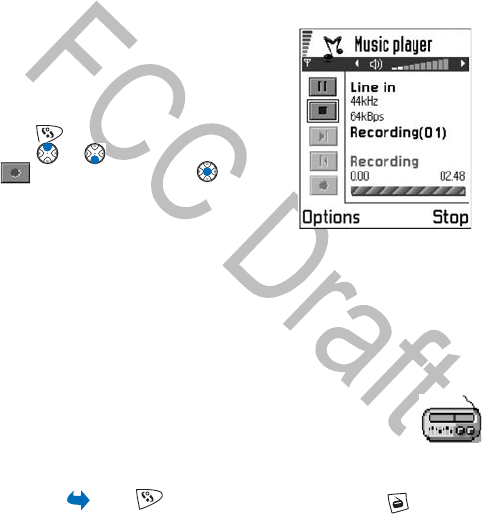
30 Copyright © Nokia 2003
Extra Bass—You can add more bass to the current music style.
Options in Settings are Change, Help, and Back.
Record from external equipment
You can connect your game deck to compatible external audio equipment, for
example, a CD-player, and record music directly to your game deck.
Do not use this feature illegally! Music can be protected by copyright. The
recording of such music tracks is permitted for your personal use only. It is illegal
to copy such music tracks for the purpose of selling or distribution. Copyright
protections may prevent some content from being copied, modified, transferred or
forwarded.
To record a music track from compatible external
audio equipment. perform the following steps:
1Connect the external audio equipment.
See “Attach and use supplied cables” on
page 11 for more information.
2Press and go to Media > Music Player.
3Press or to highlight the record
control button and press to
record.
4Press Stop to stop recording.
The music player assigns the default name
Recording to each track and attaches a
unique number so you can record multiple tracks. For example, the first track
is named Recording(01). To change the track name press Options > Track
lists > Rename.
You can answer and make calls while recording. The volume of the music player is
muted but recording continues in the background. When you end the call, the
music player view will automatically return.
•RADIO
Your game deck must be switched and it must have a headset attached
to use this feature. Do not switch the game deck on when wireless
device use is prohibited or when it may cause interference or danger.
To open Radio, press and go to Media > Radio, or press .
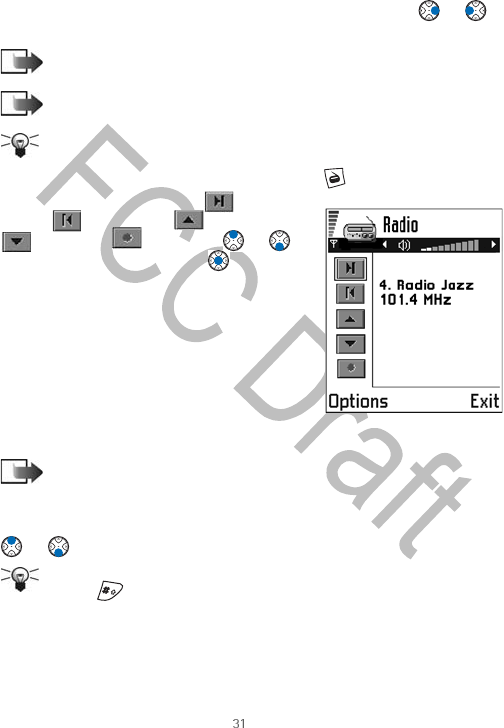
Nokia #### User Guide Copyright © Nokia 2003
Music player and radio
You can listen to the radio using either the headset (see “Attach and use the
headset” on page 10) or the loudspeaker, but the headset must be attached. The
lead of the headset functions as the antenna of the radio, so let it hang freely, and
always make sure it is connected.
To adjust the volume level of the headset or the loudspeaker, press or to
increase or decrease the volume level.
Note: The quality of the radio broadcast depends on the radio station’s
coverage in that particular area.
Listen to music at a moderate level. Continuous exposure to high volume
may damage your hearing.
Tip: Press the headset button to select the next channel.
To quickly turn on Radio press the special radio key .
You can select the next channel , previous
channel , auto tune up , auto tune down
, and record by pressing or to
highlight the control button and to select.
Options in Radio are Channels, Activate loudsp.
/Deactivate loudsp., Auto tune up, Auto tune
down, Manual tuning, Save channel, Help, and
Exit.
Tune a radio channel
When Radio is on, select Options > Auto tune up
or Auto tune down for automatic tuning. When a
channel is found, the new frequency appears.
Note: If you have radio channels already saved, then the channel number
and name may also be displayed.
Frequency range is 87.5–108.0 MHz.
You can also tune manually by selecting Options > Manual tuning and pressing
or to move the frequency up or down (0.05 MHz steps).
Tip: If you know the desired frequency, use the keypad to enter it directly
(press for a decimal point).
To save the channel in the game deck, select Options > Save channel. Scroll to the
channel location where you want to store the channel and press OK. Type in the
name of the radio station and press OK.
Empty slots show a default frequency of 87.5 MHz.
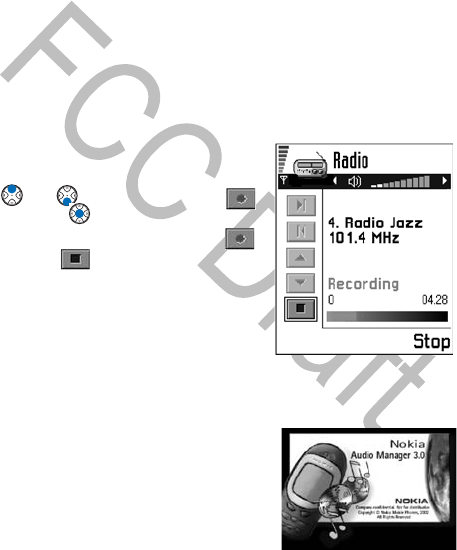
32 Copyright © Nokia 2003
Use the radio
Options in the channels list are Listen, Activate loudsp./Deactivate loudsp.,
Rename, Delete, Help, and Exit.
When the radio is on you can turn it off by pressing Cancel.
When the loudspeaker is activated the headset is muted.
You can answer and make calls while listening to the radio. During a call, the
volume of the radio is muted. When you end the call, the radio will automatically
resume.
Using the radio consumes power, and the game deck’s operating time is reduced.
If you have radio channels already saved, you can select Options > Channels to
select the channel to which you want to listen. You can also select a radio channel
location, 1–9, by pressing the corresponding number key. You can also select a
radio channel location 10–20 by pressing one numbered key immediately after
another. For example, 1 + 0 = 10, 1 + 5 = 15, and 2 + 0 = 20.
If the headset is disconnected the radio will time-out after 5 minutes and close.
Record from the radio
You can record the current radio channel by
pressing and to highlight the record
control button and to record.
When in the record mode, the record button
becomes the stop control button, or press
Stop
You can answer and make calls while recording the
radio. The radio is muted and recording continues
in the background. When you end the call, the radio
will automatically resume.
• NOKIA AUDIO MANAGER
With Nokia Audio Manager, you can select digital
music tracks on a compatible PC and transfer them
to your Nokia N-Gage game deck memory card. The
Nokia Audio Manager software also allows you to
create M3U playlists on the PC, with references to
either MP3 tracks or tracks saved from CDs. In order
for the PC to access the media storage area (memory
card) on the game deck, you must connect your
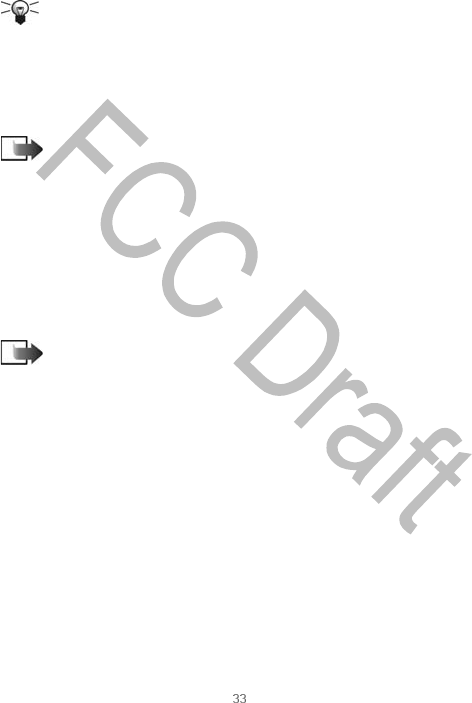
Nokia #### User Guide Copyright © Nokia 2003
Music player and radio
game deck to the PC using the supplied DKE-2 USB mini-B cable. See “Attach and
use supplied cables” on page 11. The contents of the game deck memory card can
then be displayed in the Mobile Device area of the Music Studio window of the
Nokia Audio Manager, so you work directly on the PC. The music tracks on the
playlists can be, for example, transferred from your CDs.
Tip: You can find the Nokia Audio Manager application on the CD-ROM
supplied in the sales package.
System requirements
To install and use Nokia Audio Manager, you need the following:
• An Intel compatible PC running Windows 98 Second Edition, Millennium
Edition, Windows 2000 or Windows XP operating system
Note: The software is not supported on a PC which has had its system
upgraded from Windows 95 or 3.1 to Windows 98.
• Pentium MMC 266 MHz CPU (Pentium 300 MHz recommended)
• At least 35 MB of free disk space
• Minimum of 48 MB of memory space recommended on the computer (64 MB
suggested for Windows 2000)
• Computer display with 800 x 600 pixels and more than 65536 colors, High
color settings
• CD ROM drive SCSI/ANSI X3T10-1048D standard. ATAPI/SFF-8020i standard
Install Nokia Audio Manager
Note: Do not connect the USB cable to your PC before you have installed
the Nokia Audio Manager PC software from the CD-ROM supplied in the
Nokia N-Gage game deck sales package.
1Start Windows.
2Insert the CD-ROM supplied in the sales package in the CD-ROM drive of your
PC.
3If the CD-ROM does not launch itself automatically, open Windows Explorer
and select the CD-ROM drive.
4Right click the Nokia Audio Manager icon and select Autorun.
5Follow the installation instructions that appear on the display of the computer
to successfully complete the installation.
When the installation of the software program is complete, Nokia Audio
Manager folder is added to your Programs.
6Reboot the computer after installation of the Nokia Audio Manager software.
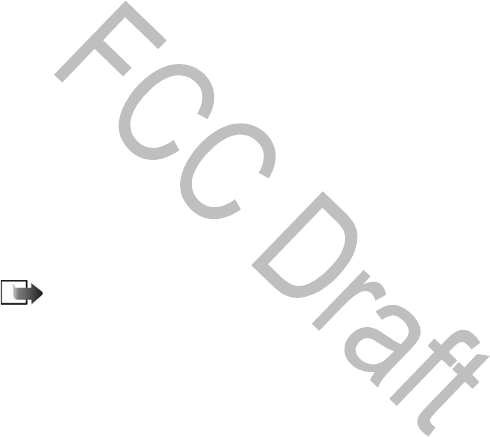
34 Copyright © Nokia 2003
MUSIC TRACK TYPES SUPPORTED
The Nokia Audio Manager supports MP3 music tracks and M3U playlists. Playlists
can be created in Music Studio. When a playlist is selected for transfer to the game
deck’s memory card, only the tracks named in the playlist are transferred. Tracks
created by the CD player have an .AAC file extension. These files can be played on
the PC by the Nokia Audio Manager and transferred to the memory card of the
game deck.
Save CD tracks
1On the PC, open Nokia Audio Manager.
The initial screen appears.
2Insert a music CD in the CD drive of your PC, and click on the CD Player icon.
3If, by default, all track information is not displayed, click on the Load CD
button.
4To save tracks, select the tracks and click on the Save tracks button.
Do not remove the CD until the save operation is complete. A progress bar will
indicate approximately how long it will take to save the tracks.
5To transfer the saved tracks to Music Studio, click the + Add button, select
the desired tracks and click Open.
6You can now transfer the tracks in Music Studio to your Nokia N-Gage game
deck.
Transfer music tracks to your device
1Save the tracks and playlists in Music Studio. See “Save CD tracks” on page 34
for further instructions.
Note: Check that the compatible PC and game deck are connected using
the supplied USB cable. See “Attach and use supplied cables” on page 11.
2On the PC, open Nokia Audio Manager.
The initial screen appears.
3Click on the icon in the mobile device area of Music Studio.
4Click on the tracks or playlists that you want to transfer to the memory card
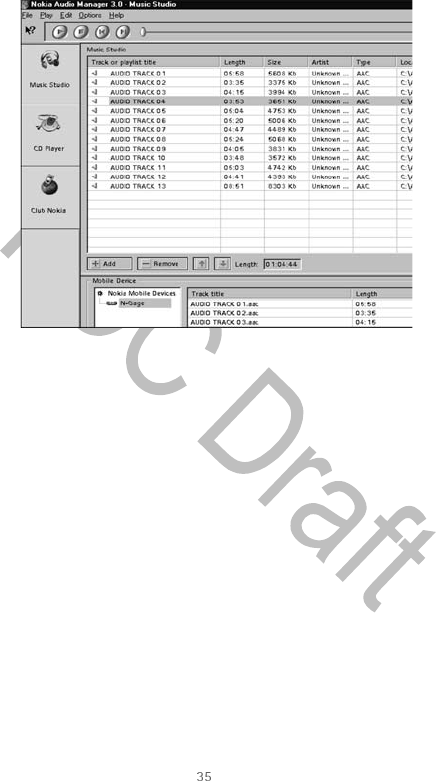
Nokia #### User Guide Copyright © Nokia 2003
Music player and radio
of your game deck.
5Click Transfer to device.
If you selected more music than can fit on the game deck memory card, you get an
error note. Remove some music tracks and try again.
Transfer using Windows Explorer
After you have installed the Nokia Audio manager, it is possible to use Windows
Explorer to transfer MP3 or .AAC music tracks to the memory card of your game
deck.
1Check that the compatible PC and game deck are connected using the supplied
USB cable. See “Attach and use supplied cables” on page 11 .
2Open Windows Explorer and display the disks mounted on the PC.
One of the lettered drives should have the name Nokia N-Gage game deck.
3Before transferring tracks using Windows Explorer, check the size of the files
to be transferred.
4Click on this to display a window that shows the contents of the game deck
memory card.
5Open a second window of Windows Explorer and display the contents of the
folder on the PC from where you wish to transfer MP3 and .AAC tracks.
6Select the tracks on the compatible PC that you wish to transfer to the game
deck and drag and drop these tracks into the first window.
The tracks will now be transferred to the game deck.

36 Copyright © Nokia 2003
Note: Windows Explorer may indicate that the file transfer is complete
before sufficient time. This is not necessarily the case and you must allow
approximately 10 seconds for each 1 MB to be transferred. If the transfer
is interrupted earlier the files may not be transferred.
If you selected more music than can fit on the memory card of the game deck, you
get an error note. Remove some music tracks and try again.
Club Nokia window
The Nokia Audio Manager includes a browser window that allows you to browse
the Internet if your computer has an internet connection. By default, this browser
has a Club Nokia home page. Any URL may be entered into the location field. To
search the Internet, the location must be set to a site that has a search engine.
Tracks from the Internet must be downloaded to the PC before they can be added
to the music studio window for transfer to the game deck.
Edit fields in tracks on the compatible PC
When tracks or playlists are displayed in Music Studio, it is possible to edit track
and artist information. See the Nokia Audio Manager help for further details.
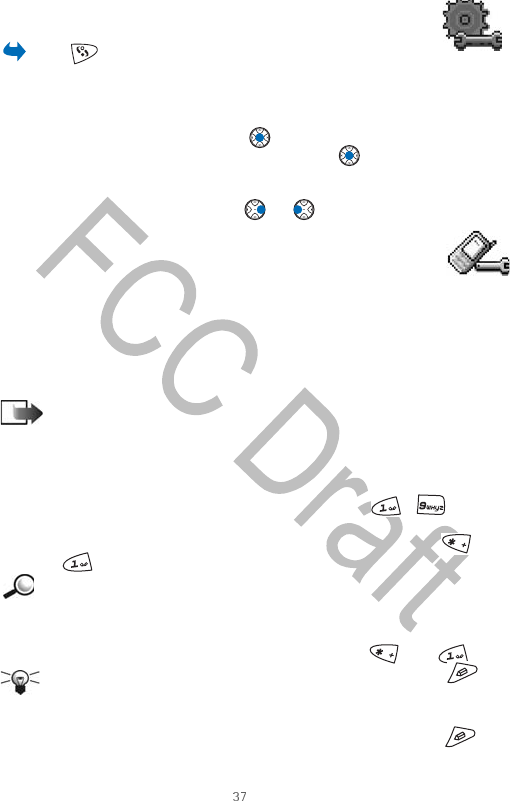
Nokia #### User Guide Copyright © Nokia 2003
Settings
6 Settings
Press and go to Tools > Settings.
• CHANGE NORMAL SETTINGS
1Scroll to a setting group and press to open it.
2Scroll to a setting you want to change and press to do the following:
• Switch between options if there are only two (On/Off)
• Open a list of options or an editor
• Open a slider view, and press or to increase or decrease the
value
Device settings
GENERAL
Device language—You can change the language for the display texts in your game
deck. This change will also affect the format used for date and time and the
separators used, for example, in calculations. If you select Automatic, the game
deck selects the language according to the information on your SIM card. After you
have changed the display text language, you must restart the game deck.
Note: Changing the settings for Device language or Writing language
affects every application in your game deck and the change remains
effective until you change these settings again.
Writing language—You can change the writing language of your game deck.
Changing the language affects the following:
• The characters available when you press any key ( — )
• The predictive text dictionary used
• The special characters that are available when you press the and
keys
Example: You are using a game deck where the display texts are in English
but you want to write all your messages in French. After you change the
language, the predictive text dictionary searches for words in French and
the most common special characters or punctuation marks used in the
French language are available when you press the and keys.
Tip: You can also make this change in some of the editors. Press and
select Writing language.
Dictionary—Sets the predictive text input On or Off for all editors in the game
deck. You can also change this setting when you are in an editor. Press and
select Dictionary > Dictionary on or Off.
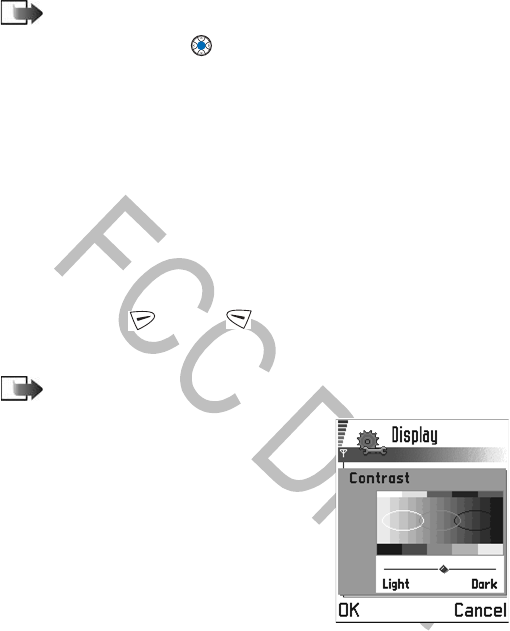
38 Copyright © Nokia 2003
Note: The predictive text dictionary is not available for all languages.
Welcome note or logo—Press to open the setting. The welcome note or logo
appears briefly each time you switch on the game deck. Select Default if you want
to use the default image. Select Text to write a welcome note (up to 50 letters).
Select Image to select a photo or picture from Images.
Orig. device settings—You can reset some of the settings to their original values.
To do this, you need the lock code. See “Security” on page 46. After resetting the
settings, the game deck may take a longer time to power on.
All documents and files you have created are left as they are.
Standby mode
Background image—You can select any image to be used as a background image
in the standby mode. Select Yes to select an image from Images.
Left selection key and Right selection key—You can change the shortcuts that
appear over the left and right selection keys in the standby mode. In
addition to the applications, you can have the shortcut point to a function, for
example, New message.
Note: You cannot have a shortcut to an application that you have
installed.
Display
Contrast—To change the contrast of the display to
lighter or darker.
Color palette—To change the color palette used on
the display.
Screen saver timeout—The screen saver is activated
when the screen saver timeout period is over. When
the screen saver is active, the display is cleared and
you can see the screen saver bar. To deactivate the
screen saver press any key.
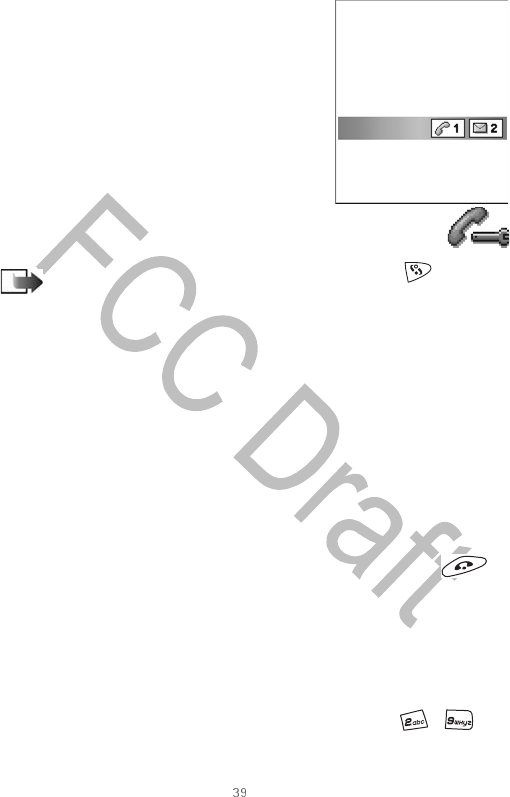
Nokia #### User Guide Copyright © Nokia 2003
Settings
Screen saver—Select what appears on the screen
saver bar: time and date or a text you have written
yourself. The location and background color of the
screen saver bar changes in one minute intervals.
Also, the screen saver changes to indicate the
number of new messages or missed calls.
Call settings
Note: To change the settings for call forwarding, press and go to
Tools > Call forward. See “Call forwarding settings” on page 18.
SEND MY CALLER ID
This network service allows you to set your phone number to be displayed (Yes) or
hidden (No) from the person to whom you are calling, or the value may be set by
your network operator or service provider when you make a subscription (Set by
network).
CALL WAITING
The network will notify you of a new incoming call while you have a call in
progress. Select Activate to request the network to activate call waiting, Cancel to
request the network to deactivate call waiting, or Check status to check if the
function is active or not.
AUTOMATIC REDIAL
When this setting is activated, your game deck will make a maximum of ten
attempts to connect the call after an unsuccessful call attempt. Press to
stop automatic redialing.
SUMMARY AFTER CALL
Activate this setting if you want the game deck to briefly display the duration and
cost of the last call. To show costs, the Call cost limit needs to be activated for
your SIM card. See page 20.
1-TOUCH DIALING
Select On and the numbers assigned to the 1-touch dialing keys ( —), can
be dialed by pressing and holding the key. See also “Assign 1-touch dialing keys”
on page 55.
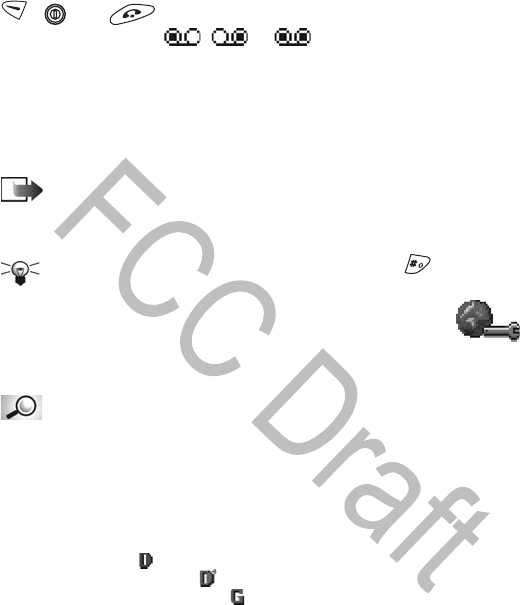
40 Copyright © Nokia 2003
ANYKEY ANSWER
Select On, and you can answer an incoming call by briefly pressing any key, except
, , and .
Voice message indicators, , , or , are shown if you have one or
several voice messages.
LINE IN USE (NETWORK SERVICE)
This setting appears only if the SIM card supports two subscriber numbers, that is,
two phone lines. Select which phone line (Line 1 or Line 2) you want to use to
make calls and send text messages. Calls on both lines can be answered irrespective
of the selected line.
Note: You will not be able to make calls if you select Line 2 and have not
subscribed to this network service.
To prevent line selection, select Line change > Disable if supported by your SIM
card. To change this setting, you need the PIN2 code.
Tip: To switch between the phone lines, press and hold in the
standby mode.
• CONNECTION SETTINGS
Data connections and access points
Glossary: Access point—The point where your game deck connects to the
Internet by way of a data call or packet data connection. An access point
can be provided, for example, by a commercial Internet service provider
(ISP), service provider for mobile devices, or network operator.
To define settings for access points, go to Settings > Connection settings > Access
points.
A data connection is required to connect to an access point. Your game deck
supports three kinds of data connections:
• A GSM data call ( )
• GSM high-speed data call ( )
• Packet data (GPRS) connection ( )
There are three different kinds of access points that you can define: MMS, browser,
and Internet access point (IAP). Your service provider will know what kind of an
access point is needed for the service you wish to access. You need to set access
point settings to do the following:
• Send and receive multimedia messages.
• Send and receive e-mail.
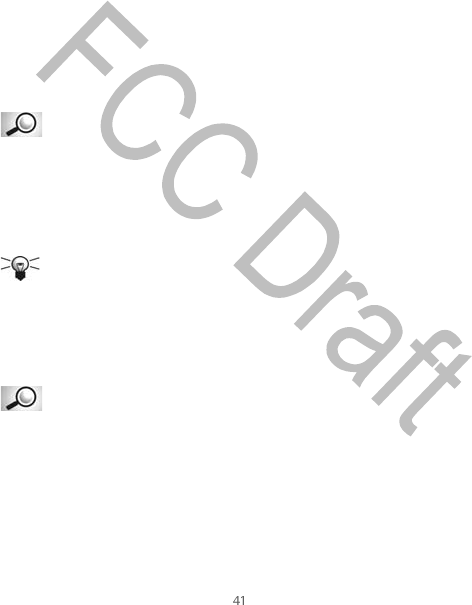
Nokia #### User Guide Copyright © Nokia 2003
Settings
• View Browser pages,
• Download Java™ applications.
• Use Image upload.
• Use your game deck as a modem.
See also “Data connection indicators” on page 6.
GSM data calls verify all settings
A GSM data call enables data transmission rates to a maximum of 14.4 kb/s. For
availability and subscription to data services, contact your network operator or
service provider.
DATA CALL SETTINGS
• To insert basic GSM data call settings, go to Settings > Connection
settings > Access points and select Options > New access point. Enter the
following: Data bearer: GSM data, Dial-up number, Session mode:
Permanent, Data call type: analog, and Maximum data speed: Automatic.
• High-speed data call (High-Speed Circuit Switched Data, HSCSD)
Glossary: High-speed data enables data transmission rates to a
maximum of 43.2 kb/s.
For availability and subscription to high-speed data services, please contact your
network operator or service provider.
Sending data in HSCSD mode may drain the game deck battery faster than normal
voice or data calls, as the game deck may send data more frequently to the
network.
Tip: The Settings wizard program included in the PC Suite for your Nokia
N-Gage game deck can help you configure access point and mailbox
settings. You can also copy existing settings, for example, from your
compatible computer to your game deck. See the CD-ROM supplied in the
sales package.
Packet data (GPRS)
Glossary: Sends (GPRS) data in short packets over the mobile network.
PACKET DATA CONNECTION SETTINGS
• You may need to subscribe to the GPRS service. Contact your network operator
or service provider.
•Go to Settings > Connection settings > Access points and select Options >
New access point. Fill in the following: Data bearer: GPRS and Access point
name: enter the name given by your service provider. See “Create an access
point” on page 42 for further information.
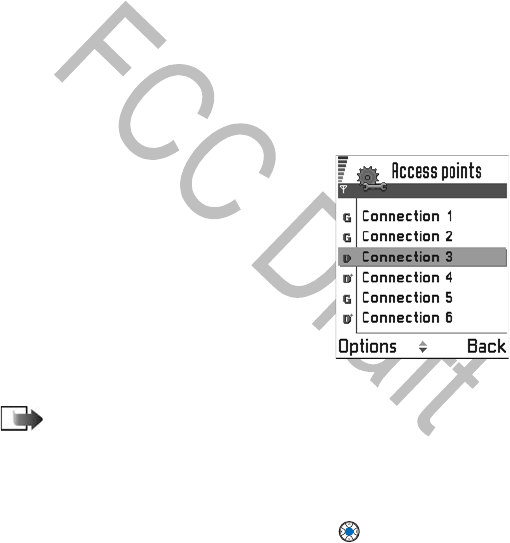
42 Copyright © Nokia 2003
PACKET DATA AND APPLICATIONS PRICING
Both the active GPRS connection and the applications used over GPRS require a
fee. For more detailed information on fees, contact your network operator or
service provider. See also “Packet data counter and connection timer” on page 22.
Create an access point
Options in the Access points list are Edit, New access point, Delete, Help, and
Exit.
You may have preset access point settings in your game deck, or you may receive
access point settings in a smart message from a service provider. See “Receive
smart messages” on page 79.
If there are no access points defined when you open Access points, you will be
asked if you want to create one.
If access points are defined, create a new access point, by selecting Options > New
access point. Then select from the following:
•Use default settings to use the default settings. Make the needed changes and
press Back to save the settings.
•Use existing settings to use existing setting
information as the basis for the new access
point settings. A list of existing access points is
opened. Select one and press OK. Access point
settings are opened with some fields already
filled.
Access points
Options when editing access point settings are
Change, Advanced settings, Help, and Exit.
Here you can see a short explanation for every
setting that may be needed for different data
connections and access points.
Note: Start to fill in the settings from the top because depending on what
data connection you select (Data bearer) or whether you need to insert a
Gateway IP address, only certain setting fields are available. Carefully
follow the instructions given by your service provider.
EDIT
When you open Access points, the list of currently available access points opens.
Scroll to the access point you want to edit, and press .
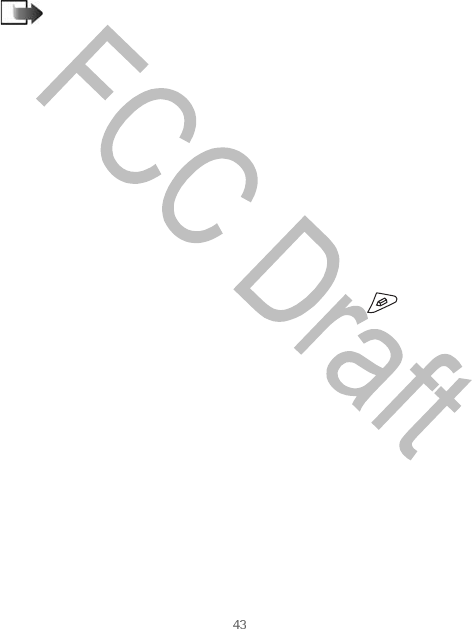
Nokia #### User Guide Copyright © Nokia 2003
Settings
DELETE
In the list of access points, scroll to the access point you want to remove and select
Options > Delete.
Connection name—Enter a descriptive name for the connection.
Data bearer—The options are GSM data, High speed GSM, and GPRS. Depending
on what data connection you select, only certain setting fields are available. Fill in
all fields marked with Must be defined or with a red asterisk. Other fields can be
left empty, unless you have been instructed otherwise by your service provider.
Note: To be able to use a data connection, the network service provider
must support this feature, and if necessary, activate it for your SIM card.
Access point name (for packet data only)—The access point name makes a
connection to the GPRS network. You obtain the access point name from your
network operator or service provider.
Dial-up number (for GSM data and high-speed data only)—The modem telephone
number of the access point.
User name—Write a user name if required by the service provider. The user name
may be needed to make a data connection, and is usually given by the service
provider. The user name is often case-sensitive.
Prompt password—If you must key in a new password every time you log on to a
server, or if you do not want to save your password to the game deck, choose Yes.
Password—A password may be needed to make a data connection, and is usually
given by the service provider. The password is often case-sensitive. When you are
writing the password, the characters you enter are shown briefly and then changed
to asterisks (*). The easiest way to enter numbers is to press and select Insert
number and then continue entering letters.
Authentication—Normal or Secure.
Gateway IP address—The IP address that the required Browser gateway uses.
Homepage—Depending on what you are setting up, write either the service
address, or the address of the multimedia messaging center.
Connection security—Choose whether Transport Layer Security (TLS) is used for the
connection. Follow the instructions given by your service provider.
Session mode—Permanent or Temporary.
Data call type (for GSM data and high-speed data only)—analog, ISDN v.110, or
ISDN v.120 defines whether the game deck uses an analog or digital connection.
This setting depends on both your GSM network operator and Internet Service
Provider (ISP), because some GSM networks do not support certain types of ISDN
connections. For details, contact your ISP. If ISDN connections are available, they
establish connections more quickly than analog methods.
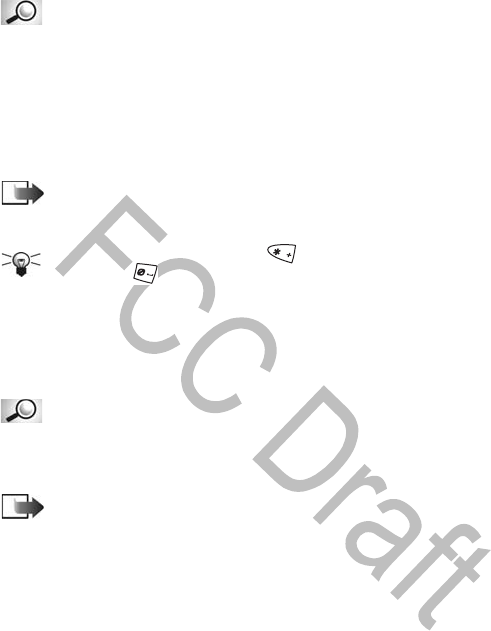
44 Copyright © Nokia 2003
ISDN connections are a way to establish a data call between your game
deck and your access point. ISDN connections are digital from end to end
and as such offer quicker set-up times and faster data rates than analog
connections. In order to use an ISDN connection, both your Internet service
provider and network operator must support it.
Maximum data speed (for GSM data and high-speed data only)—The options are
Automatic, 9600, 14400, 19200, 28800, 38400, or 43200, depending on what you
have chosen in Session mode and Data call type. This option allows you to limit
the maximum connection speed when high-speed data is used. Higher data rates
may cost more, depending on the network service provider.
Note: The speeds above represent the maximum speed at which your
connection will operate. During the connection, the operating speed may be less,
depending on network conditions.
Tip: When you are writing, press to open the special characters
table. Press to enter a space.
See also “Settings” on page 73, “E-mail settings” on page 89, and “Set up browser
service” on page 106.
ADVANCED SETTINGS OPTIONS
Device IP address—The IP address of your phone.
Primary name server—The IP address of the primary DNS server.
Glossary: DNS—(domain name service). An Internet service that translates
domain names such as www.NokiaUSA.com into IP addresses like
192.100.124.195.
Second. name server—The IP address of the secondary DNS server.
Note: If you need to enter the Device IP address, Primary name server,
or Second. name server, contact your Internet service provider to obtain
these addresses.
The following settings are shown if you have selected data call and high-speed
data as the connection type:
Use callback—This option allows a server to call you back once you have made the
initial call. Contact your service provider to subscribe.
Callback type—The options are Use server no. or Use other no.. Ask your service
provider for the correct setting to use; it will depend on the service provider’s
configuration.
Callback number—Key in your game deck data phone number. Usually this number
is the data call phone number of your game deck.
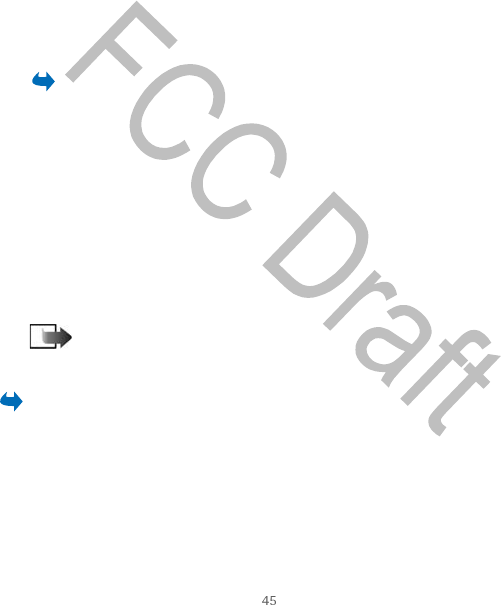
Nokia #### User Guide Copyright © Nokia 2003
Settings
Use PPP compression—When set to Yes, this option speeds up the data transfer, if
supported by the remote PPP server. If you have problems with establishing a
connection, try setting this to No. Contact your service provider for guidance.
PPP (point-to-point protocol)—a common networking software protocol that
enables any computer with a modem and a phone line to connect directly to the
Internet.
•Use login script—The options are Yes or No.
•Login script—Insert the login script.
•Modem initialization (modem initialization string)—Controls your game deck
using modem AT commands. If required, enter characters specified by your
GSM network service provider or Internet service provider.
• GPRS
Go to Settings > Connection settings > GPRS.
The GPRS settings affect all access points using a packet data connection.
GPRS connection—If you select When available and you are in a network that
supports packet data, the game deck registers to the GPRS network and sending
text messages will be done using GPRS. Also, starting an active packet data
connection, for example, to send and receive e-mail, is quicker. If you select When
needed, the game deck will use a packet data connection only if you start an
application or action that needs it.
Access point—The access point name is needed when you want to use your game
deck as a packet data modem to your computer. For more information on modem
connections, see “Quick guide for Nokia modem options” on the game CD supplied
with the game deck.
Note: If there is no GPRS coverage and you have chosen When available,
the game deck will periodically try to establish a packet data connection.
Data call
Select Settings > Connection setting > Data call.
The data call settings affect all access points using a data call and high-speed data
call.
Online time—If there are no actions the data call is dropped automatically after a
time-out period. The options are User defined, in which case you enter a time, or
Unlimited.
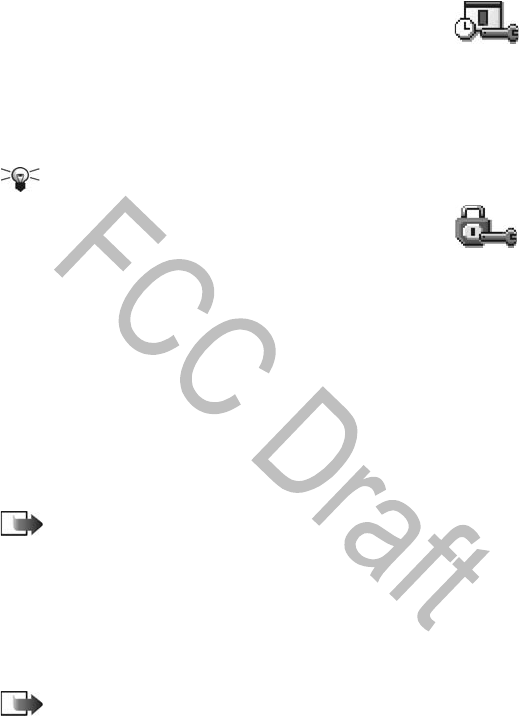
46 Copyright © Nokia 2003
Date and time
The date and time settings allow you to define the date and time used in your game
deck, as well as change the date and time format and separators. Choose Clock
type > analog or Digital to change the clock shown in the standby mode. Choose
Auto time update if you want the mobile phone network to update time, date, and
time zone information to your game deck (network service). You must restart your
game deck for Auto Time Update settings to take effect.
Tip: See also “Device settings” on page 37.
s
•SECURITY
Device and SIM
Explanations for the different security codes that may be needed:
PIN code (4–8 digits)—The PIN code protects your SIM card against unauthorized
use. The PIN code is usually supplied with the SIM card.
After three consecutive incorrect PIN code entries, the PIN code is blocked. If
the PIN code is blocked, you need to unblock the PIN code before you can use
the SIM card again. See the information about the PUK code.
PIN2 code (4–8 digits)—The PIN2 code, supplied with some SIM cards, is required
to access some functions, such as call cost counters.
Lock code (5 digits)—The lock code can be used to lock the game deck and keypad
to avoid unauthorized use.
Note: The factory setting for the lock code is 12345. To avoid
unauthorized use of your game deck, change the lock code. Keep the new
code secret and in a safe place separate from your game deck.
PUK and PUK2 codes (8 digits)—The PUK (Personal Unblocking Key) code is
required to change a blocked PIN code. The PUK2 code is required to change a
blocked PIN2 code. If the codes are not supplied with the SIM card, contact the
operator whose SIM card is in your game deck for the codes.
You can change the lock code, PIN code, and PIN2 code. These codes can only
include numbers, 0–9.
Note: Avoid using access codes similar to emergency numbers, such as
911.
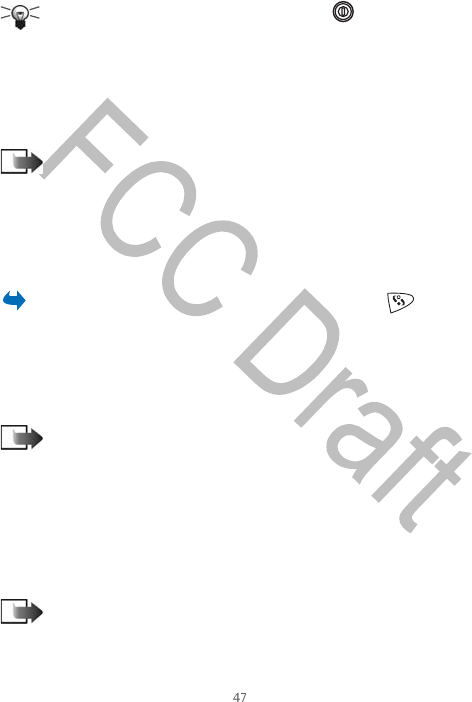
Nokia #### User Guide Copyright © Nokia 2003
Settings
PIN code request—When the PIN code request is active, the code is requested each
time the game deck is switched on. Note that deactivating the PIN code request
may not be allowed by some SIM cards.
PIN code, PIN2 code, or Lock code—Open this setting if you want to change the
code.
Tip: To lock the game deck manually, press . A list of commands
opens. Select Lock device.
Autolock period—You can set an autolock period, a time-out after which the game
deck is automatically locked and can be used only if the correct lock code is
entered. Key in a number for the time-out in minutes or select None to turn off the
autolock period.
To unlock the game deck, key in the lock code.
Note: When the game deck is locked, calls may be possible to the
emergency number programed into your game deck (such as 911).
Lock if SIM changed—Select Yes if you want the game deck to ask for the lock code
when an unknown, new SIM card is inserted into your game deck. The game deck
maintains a list of SIM cards that are recognized as the owner’s cards.
Options in the Fixed dialing view are Open, Call, New contact, Edit, Delete, Add
to Contacts, Add from Contacts, Help, and Exit.
To view the list of Fixed dialing numbers, press and go to
Tools > Fixed dialing.
Fixed dialing—You can restrict your outgoing calls to selected phone numbers, if
supported by your SIM card. You need the PIN2 code for this function. When this
function is active, you can only call those phone numbers that are included in the
fixed dialing list or which begin with the same digits as a phone number on the list.
Note: When Fixed dialing is set on, calls may be possible to certain
emergency numbers in some networks (such as 911).
• To add new numbers to the fixed dialing list, select Options > New contact or
Add from Contacts.
Closed user group—You can specify a group of people to whom you can call and
who can call you. For more information, contact your network operator or service
provider. Select Default to activate the default group agreed on with the network
operator, On if you want to use another group (you need to know the group index
number), or Off.
Note: When calls are limited to Closed User Groups, calls may be possible
to certain emergency numbers in some networks (such as 911,or other
official emergency number).
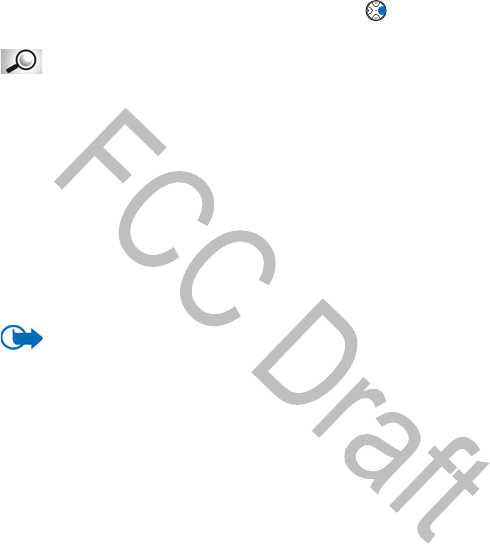
48 Copyright © Nokia 2003
Confirm SIM services (network service)—To set the game deck to display
confirmation messages when you are using a SIM card service.
Certificate management
In the Certificate management main view, you can see a list of authority
certificates that have been stored in your game deck. Press to see a list of user
certificates, if available.
Glossary: Authority certificates are used by some browser services, such
as banking services, for checking signatures or server certificates or other
authority certificates. User certificates are issued to users by a certifying
authority.
Options in the certificate management main view are Certificate details, Delete,
Trust settings, Mark/Unmark, Help, and Exit.
Digital certificates should be used if you want to do the following:
• Connect to an online bank or another site or remote server for actions that
involve transferring confidential information.
• Reduce the risk of viruses or other malicious software and be sure of the
authenticity of software when downloading and installing software.
Digital certificates are used to verify the origin of browser pages and installed
software. However, they can only be trusted if the origin of the certificate is known
to be authentic.
Important: The existence of a certificate does not offer any protection
by itself; the certificate manager must contain correct, authentic, or
trusted certificates for increased security to be available.
CERTIFICATE DETAILS—CHECKING AUTHENTICITY
You can only be sure of the correct identity of a browser gateway or a server when
the signature and the period of validity of a browser gateway or server certificate
have been checked.
You will be notified on the game deck display if the identity of the browser server
or gateway is not authentic or if you do not have the correct security certificate in
your game deck
To check certificate details, scroll to a certificate and select Options > Certificate
details. When you open certificate details, certificate management checks the
validity of the certificate and one of the following notes may appear:
Certificate not trusted—You have not set any application to use the certificate. For
more information, see See “Change trust settings” on page 49.
Expired certificate—The period of validity has ended for the selected certificate.
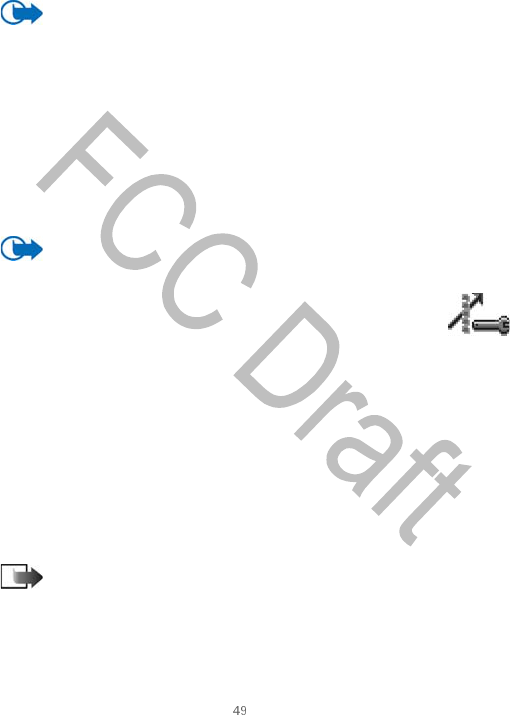
Nokia #### User Guide Copyright © Nokia 2003
Settings
Certificate not valid yet—The period of validity has not yet begun for the selected
certificate.
Certificate corrupted—The certificate cannot be used. Contact the certificate
issuer.
Important: Certificates have a restricted lifetime. If Expired certificate
or Certificate not valid yet appears even if the certificate should be valid,
check that the current date and time in your game deck are correct.
CHANGE TRUST SETTINGS
Scroll to an authority certificate and select Options > Trust settings. Depending
on the certificate, a list of the applications that can use the selected certificate
appears. For example:
Services > Yes—the certificate is able to certify sites.
Application manager > Yes—the certificate is able to certify the origin of new
software.
Internet > Yes—the certificate is able to certify e-mail and imaging servers.
Important: Before changing these settings, you must make sure that you
trust the owner of the certificate and that the certificate belongs to the
listed owner.
• CALL RESTRICTIONS
Call restrictions is a network service that allows you to restrict the making and
receiving of calls with your game deck. For this function, you need the restriction
password, which you can obtain from your service provider.
Scroll to one of the barring options.
•Select Options > Activate to request the network to set call restriction on,
Cancel to set the selected call restriction off, or Check status to check if the
calls are barred or not.
•Select Options > Edit restrictions passw. to change the restriction
password.
•Select Options > Cancel all restrictions to cancel all active call
restrictions.
Note: When calls are barred, calls may be possible to certain emergency
numbers in some networks (such as 911).
Call restrictions affects all calls, including data calls.
You cannot have incoming calls restrictions, call forwarding, or fixed dialing active
at the same time. See “Call forwarding settings” on page 18.
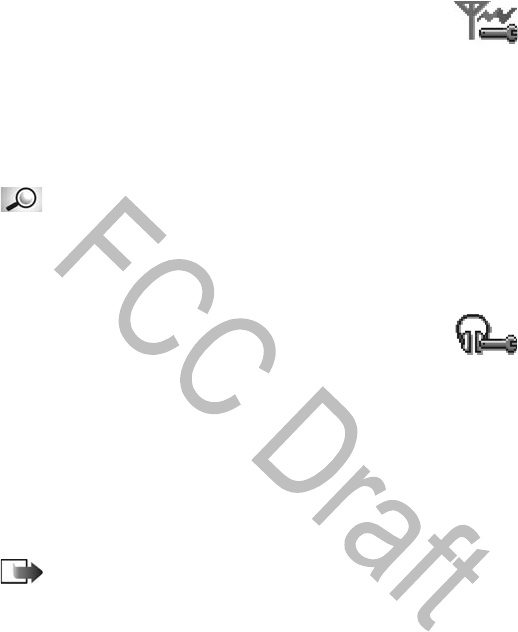
50 Copyright © Nokia 2003
Network
NETWORK SELECTION
•Automatic sets the game deck to automatically search for and select one of
the cellular networks available in your area, or
•Manual lets you select the desired network manually from a list of networks.
If the connection to the manually selected network is lost, the game deck will
sound an error tone and ask you to select a network again. The selected
network must have a roaming agreement with your home network, that is, the
operator whose SIM card is in your game deck.
Glossary: Roaming agreement—An agreement between two or more
network service providers to enable the users of one service provider to
use the services of other service providers.
CELL INFO DISPLAY
Select On to set the game deck to indicate when it is used in a cellular network
based on Micro Cellular Network (MCN) technology and to activate cell info
reception.
Enhancement settings
Indicators shown in the standby mode are as follows: NEED ICONS
A headset is connected.
A loopset is connected.
Scroll to an enhancement folder and open the settings:
•Select Default profile to select the profile you want to be activated each time
when you connect a certain enhancement to your game deck. See “Profiles”
on page 92.
•Select Automatic answer to set the game deck to answer an incoming call
automatically after five seconds. If the Incoming call alert is set to Beep once
or Silent, automatic answer cannot be in use.
Note: If you are using a loopset, you must activate it separately. Open the
loopset folder and select Use loopset > Yes. If you have activated a
loopset, the headset will use the same settings as the loopset.
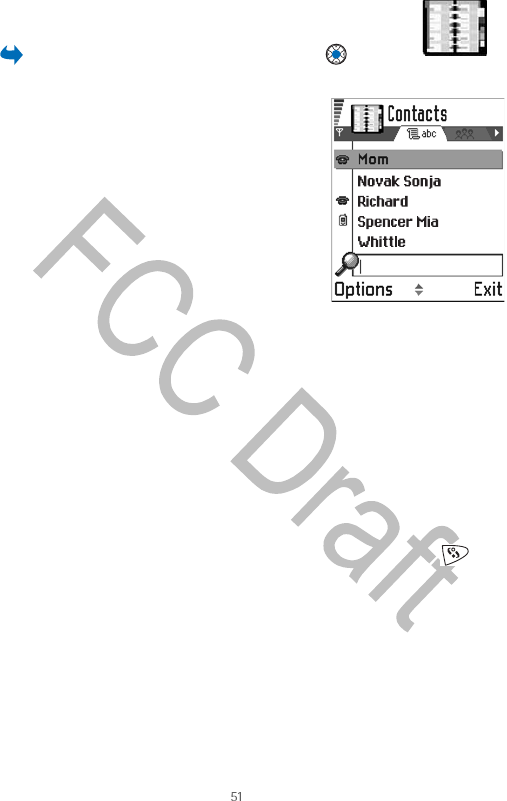
Nokia #### User Guide Copyright © Nokia 2003
Contacts
7 Contacts
To open Contacts, in the standby mode press or press
Contacts.
In Contacts, you can store and manage contact
information, such as names, phone numbers, and
addresses. Contacts use shared memory. See “Shared
memory” on page 12.
You can also add a personal ringing tone, voice tag,
or a thumbnail image to a contact card. You can
create contact groups, which allow you to send text
messages or e-mail to many recipients at the same
time.
Options in the Contacts directory are Open, Call,
Create message, New contact, Edit, Delete,
Duplicate, Add to group, Belongs to groups,
Mark or Unmark, Send business card, Contacts info, Help, and Exit.
• CREATE CONTACT CARDS
1Open Contacts and select Options > New contact.
An empty contact card opens.
2Fill in the fields you want and press Done.
The contact card is saved and closed, after which you can see it in the Contacts
directory.
Copy contacts
To copy names and numbers from a SIM card to your game deck, press and
go to Tools > SIM directory. Select the names you want to copy and select Options
> Copy to Contacts.
If you want to copy a telephone, fax, or pager number from Contacts to your SIM
card, go to Contacts, open a contact card, scroll to the number, and select
Options > Copy to SIM direct.
• EDIT CONTACT CARDS
Options when editing a contact card are Add thumbnail or Remove thumbnail,
Add detail, Delete detail, Edit label, Help, and Exit.
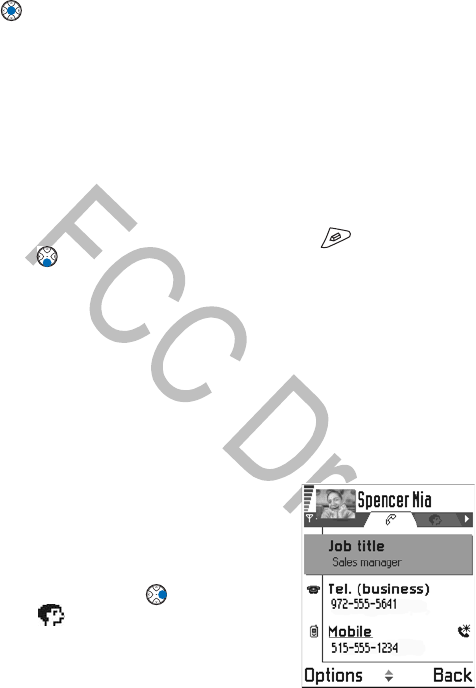
52 Copyright © Nokia 2003
1In the contacts directory, scroll to the contact card you want to edit and press
to open it.
2To change the information on the card, select Options > Edit.
3To save your changes and to return to the contact card view, press Done.
Delete
In the Contacts directory, scroll to the contact card you want to delete and select
Options > Delete.
1Mark the cards to be deleted: scroll to a contact you want to delete and select
Options > Mark.
A check mark is placed next to the contact card.
2When you have marked all the contacts you want to delete, select Options >
Delete.
You can also mark many items if you press and hold and simultaneously
press .
Add and remove
Open a contact card \and select Options > Edit.
To add an extra field, select Options > Add detail.
To delete a field you do not need, select Options > Delete detail.
To rename a contact card field label, select Options > Edit label.
Insert a picture
There are two different types of pictures you can add to a contact card. See “Images
and Screen shot” on page 58 for more information on how to store pictures.
• To attach a small thumbnail image to a contact
card, open a contact card, select Options >
Edit and then select Options > Add
thumbnail. The thumbnail image is also shown
when the contact is calling you.
• To add an image to a contact card, open a
contact card, and press to open the Image
view ( ). To attach an image, select
Options > Add image.
• VIEW A CONTACT CARD
Options when viewing a contact card, when the selection is on a telephone
number are Call, Create message, Edit, Delete, Defaults, Add voice tag or Voice
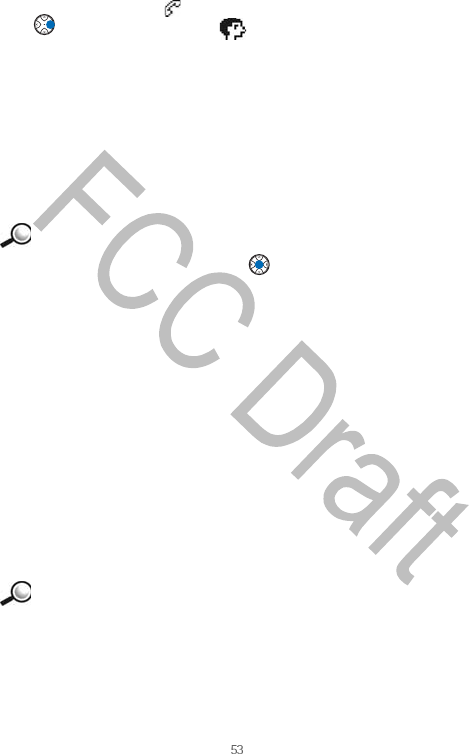
Nokia #### User Guide Copyright © Nokia 2003
Contacts
tags, Assign or Remove 1-touch dial, Ringing tone, Copy to SIM direct., Send
business card, Help, and Exit.
Contact information view ( ) shows all information inserted in the contact card.
Press to open the Image view ( ).
Only fields that have information appear in the contact information view. Select
Options > Edit to see all fields and add data to the contact.
Assign default numbers and addresses
If a contact has several telephone numbers or e-mail addresses, to speed up calling
and sending messages, you can define certain numbers and addresses to be used
as the default.
Open a contact card and select Options > Defaults. A popup window opens, listing
the different options.
Example: Scroll to Phone number and press Assign. A list of phone
numbers in the selected contact card appears. Scroll to the one you want
to have as the default and press . When you return back to the contact
card view, you can see the default number underlined.
•VOICE DIALING
You can make a phone call by speaking a voice tag that has been added to a contact
card. Any spoken words can be a voice tag. Before using voice dialing, note the
following:
• Voice tags are not language-dependent. They are dependent on the speaker's
voice.
• Voice tags are sensitive to background noise. Record them and make calls in a
quiet environment.
• Very short names are not accepted. Use long names and avoid similar names
for different numbers.
• You must say the name exactly as you said it when you recorded it. This may
be difficult in, for example, a noisy environment or during an emergency, so
you should not rely solely upon voice dialing in all circumstances.
Example: You can use a person’s name for a voice tag, for example,
“John’s mobile.”
Add a voice tag
Voice tags can only be added to phone numbers stored in the game deck memory.
See “Copy contacts” on page 51. You can have only one voice tag per contact card.
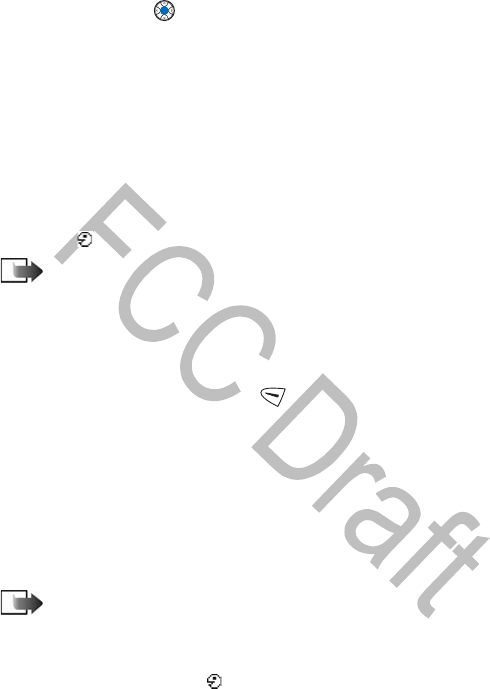
54 Copyright © Nokia 2003
1In the Contacts directory, scroll to the contact to which you want to add a
voice tag and press to open the contact card.
2Scroll to the number to which you want to add the voice tag and select
Options > Add voice tag. The message Press Start, then speak after tone
appears.
3Press Start to record a voice tag.
The game deck sounds a starting tone and Speak now appears.
When recording, hold the game deck at a short distance away from your
mouth. After the starting tone, say clearly the words you want to record as a
voice tag. After recording, the game deck plays the recorded tag and Playing
voice tag appears.
4If you do not want to save the recording, press Quit.
When the voice tag is saved, Voice tag saved appears and a beep sounds. A
symbol appears next to the number in the contact card.
Note: Your game deck will store up to 25 voice tags attached to phone
numbers. If the memory becomes full, delete some of the voice tags.
To view a list of defined voice tags, select Options > Contacts info > Voice tags
in the Contacts directory.
MAKE A VOICE TAG CALL
To make a call by using a voice tag, end all active data connections.
1In the standby mode, press and hold .
A short tone sounds and Speak now appears.
When you are making a call by saying a voice tag, the loudspeaker is in use.
2Hold the game deck at a short distance away from your mouth and say the
voice tag clearly. You must say the voice tag exactly as you said it when you
recorded it.
The game deck plays the original voice tag, displays the name and number, and
after 1.5 seconds dials the number of the recognized voice tag.
3If the game deck plays the wrong voice tag or to retry voice dialing, press
Retry.
Note: When an application using a data call or GPRS connection is
sending or receiving data, you cannot make a call by using voice dialing.
REPLAY, ERASE, OR CHANGE A VOICE TAG
To replay, erase, or change a voice tag, open a contact card and scroll to the number
that has a voice tag (indicated by ) and select Options > Voice tags > and either
one of the following:
Playback—to listen to the voice tag again
Delete—to erase the voice tag
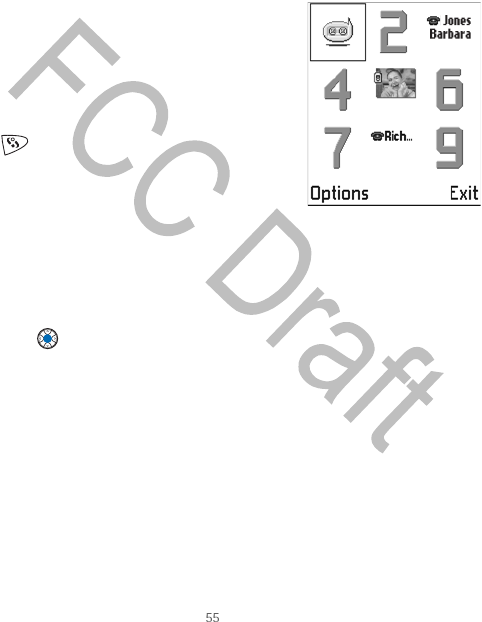
Nokia #### User Guide Copyright © Nokia 2003
Contacts
Change—to record a new voice tag. (Press Start to record.)
• ASSIGN 1-TOUCH DIALING KEYS
Use 1-touch dialing as a quick way to call frequently used numbers. You can assign
1-touch dialing keys to eight phone numbers. Number 1 is reserved for the voice
mailbox.
1Open the contact card for which you want a 1-touch dialing key and select
Options > Assign 1-touch dial.
The 1-touch dialing grid opens, showing you
the free numbers.
2Scroll to a number and press Assign.
When you return to the contact information
view, you can see the 1-touch dial icon next to
the number.
3To call the contact by 1-touch dialing, press
, go to Tools > Settings > Call > 1-touch
dialing, set the function to On, go to the
standby mode, and press and hold the 1-touch
dialing key until the call is started.
• ADD A RINGING TONE
You can set a ringing tone for each contact card and group. When that contact or
group member calls you, the game deck plays the chosen ringing tone (if the
caller’s telephone number is sent with the call and your game deck recognizes it).
1Press to open a contact card or go to the Groups list and select a contact
group.
2Select Options > Ringing tone.
A list of ringing tones opens.
3Use the controller key to select the ringing tone you wish to use for the
contact or group and press Select.
4To remove the ringing tone, select No personal tone from the list of ringing
tones.
For an individual contact, the game deck always uses the ringing tone that was
assigned last. So, if you first change a group ringing tone and then the ringing tone
of a single contact that belongs to that group, the ringing tone of the single
contact will be used when the contact calls you the next time.
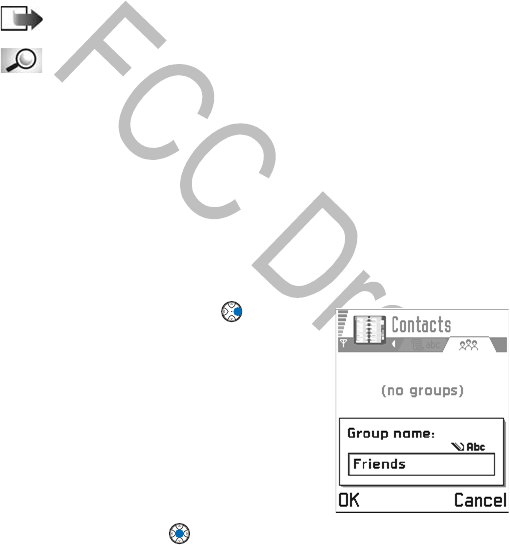
56 Copyright © Nokia 2003
• SEND CONTACT INFORMATION
1In the contacts directory, scroll to the card you want to send.
2Select Options > Send bus. card then select the method.
The choices are Via text message, Via e-mail (available only if the correct
e-mail settings are in place), and via Bluetooth. The contact card you want to
send has now become a “business card”. For further information, see the
“Messaging” chapter, and “Send data” on page 121.
You can add received business cards to your Contacts directory. See “Receive smart
messages” on page 79 for further information.
Note: Contact information can only be sent to or received from
compatible devices.
Glossary: When you send or receive contact information, the term
“business card” is used. A business card is a contact card in a format
suitable to be sent in a text message, usually in “vCard” format.
• MANAGE CONTACT GROUPS
You can create contact groups, which can, for example, be used as distribution lists
for sending text messages and e-mail. See also page 55 for how to add a ringing
tone for a group.
Options in the Groups list view are Open, New group, Delete, Rename, Ringing
tone, Contacts info, Help, and Exit.
Create contact groups
1In the contacts directory, press to open the
groups list.
2Select Options > New group.
3Write a name for the group or use the default
name Group and press OK.
Add members
1In the contacts directory, scroll to the contact
you want to add to a group and select
Options > Add to group.
A list of available groups opens.
2Scroll to the group to which you want to add
the contact and press .
You can also add multiple members.

Nokia #### User Guide Copyright © Nokia 2003
Contacts
1In the groups list, open a group and select Options > Add members.
2Scroll to a contact and press to mark it.
Repeat this action on all the contacts you want to add and press OK to add
them to the selected group.
Remove members
1Go to the groups list, scroll to the group you want to modify, and press .
2Scroll to the contact you want to remove and select Options > Remove from
group.
3Press Yes to remove the contact from the group.
Data import
You can move calendar, contacts, and to-do data from many different Nokia
phones to your game deck using PC Suite for Nokia N-Gage game deck data import
application. See PC Suite online help for the Nokia N-gage game deck data import
application.
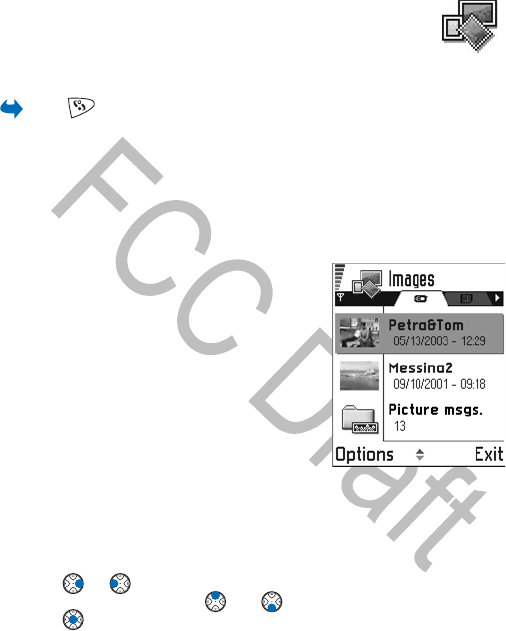
58 Copyright © Nokia 2003
8 Images and Screen shot
•IMAGES
Your game deck must be switched on to use this function. Do not switch
the game deck on when wireless device use is prohibited or when it may cause
interference or danger.
Press and go to Media > Images.
Store pictures
Images allows you to view, organize, delete, and send photos and pictures stored
in your game deck. In Images you can organize images sent to your Inbox in a
multimedia or a picture message, as an e-mail attachment, using a Bluetooth
connection, or saved from the screen shot application. After receiving the image in
Inbox, you need to save it in Images.
In the images main view you can see a list of photos
and folders. In the list you can see the following:
• The date and time an image was saved
• A small thumbnail picture
• The number of items inside a folder
• A tab showing whether the images or folders
are located in the game deck memory or the
memory card, if used.
Options in Images are Open, Send, Image
uploader, Delete, Move to folder, New folder,
Mark/Unmark, Rename, View details, Add to
favorites, Update thumbnails, Help, and Exit.
View images
When you open Images and you use a memory card, the starting tab is determined
by which memory is selected as the Memory in use.
1Press or to move from one memory tab to another.
2To browse the images, press and .
3Press , to open an image.
When the image is open, you can see the name of the image and the number
of images in the folder on the top of the display.
Options when viewing an image are Send, Rotate, Zoom in, Zoom out, Full
screen, Delete, Rename, View details, Add to favorites, Help, and Exit.
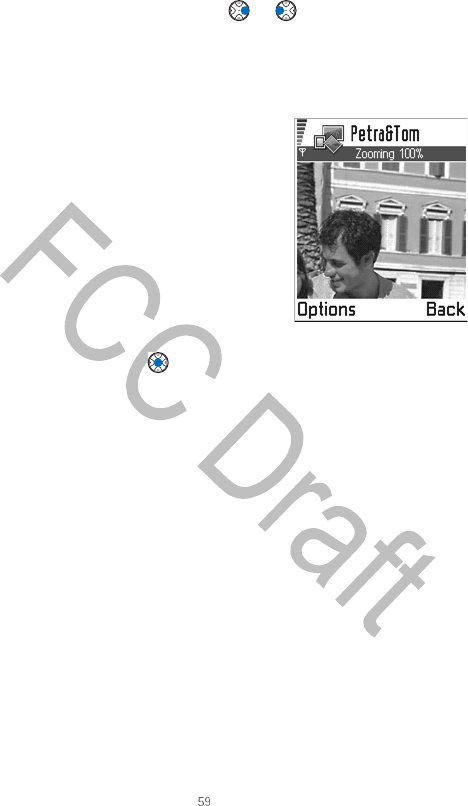
Nokia #### User Guide Copyright © Nokia 2003
Images and Screen shot
When you are viewing an image, pressing or takes you to the next or
previous picture in the current folder.
You can view animated GIF files in the same way as other images. Animations are
played only once. When an animation stops, you will see a fixed image. To view the
animation again, you must close it and then reopen it.
ZOOM IN OR OUT
1Select Options > Zoom in or Zoom out.
You can see the zooming ratio at the top of
the display. See also section “Keyboard
shortcuts” in this chapter.
2Press Back to return to the initial view.
The zoom ratio is not stored permanently.
You cannot zoom in on GIF animations while
they are playing.
FULL SCREEN
When you select Options > Full screen, the panes
around the picture are removed so that you can
see more of the image. Press to go back to the initial view.
MOVE THE FOCUS
When you are zooming or viewing an image in full screen mode, use the controller
key to move the focus to the left, right, up, or down, so that you can take a closer
look at one part of the picture, for example, its upper right corner.
ROTATE
Select Options > Rotate > Left to rotate an image 90 degrees counter-clockwise
or Options > Rotate > Right to rotate the image clockwise. The rotation status is
not stored permanently.
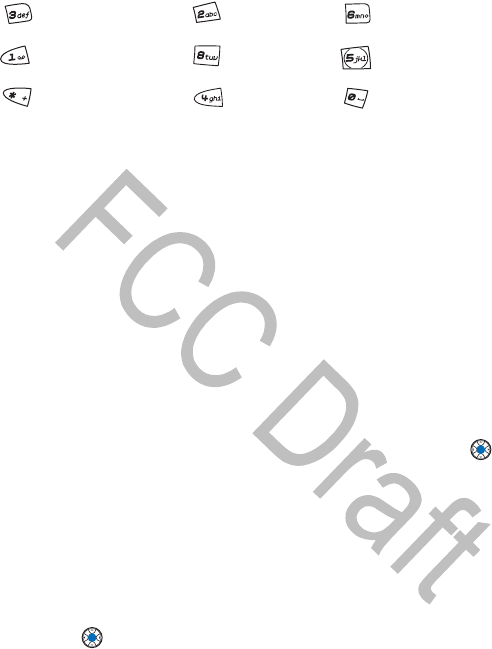
60 Copyright © Nokia 2003
KEYBOARD SHORTCUTS
IMAGE DETAILS VIEW
To view the detailed information about an image, scroll to the image and select
Options > View details. A list of image information appears:
Format—JPEG, GIF, PNG, TIFF, MBM, BMP, WBMP, OTA, WMF, Unsupported, or
Unknown.
Date and Time—when the image was created or saved
n x n- the size of the image in pixels
Size—in bytes or kilobytes
Color—True color, 65536 colors, 4096 colors, 256 colors, 16 colors, Greyscale, or
Black/white
Arrange images and folders
• To remove an image or folder, scroll to it and select Options > Delete.
• To rename an image or a folder, scroll to the image or folder you want to
rename and select Options > Rename. Write the new name and press .
See “Application Actions” on page 8 for further information on how to create
folders and mark and move items to folders.
Send images
You can send images using different messaging services to compatible devices.
1Scroll to the image you want to send and select Options > Send.
2Select the method from the following choices: Via multimedia, Via e-mail or
Via Bluetooth.
If you select to send the image in an e-mail or a multimedia message, an editor
opens. Press to select the recipients from the Contacts directory or write the
phone number or e-mail address of the recipient in the To: field. Add text or sound
and select Options > Send For more information, see “Create and send new
messages” on page 71.
If you want to send the image using a Bluetooth connection, see “Send data” on
page 121 for more information.
rotate
clockwise
scroll up scroll right
rotate
counter-clockwise
scroll down Zoom in
Toggle Screen view
(Press and hold to
return to normal view)
scroll left Zoom out
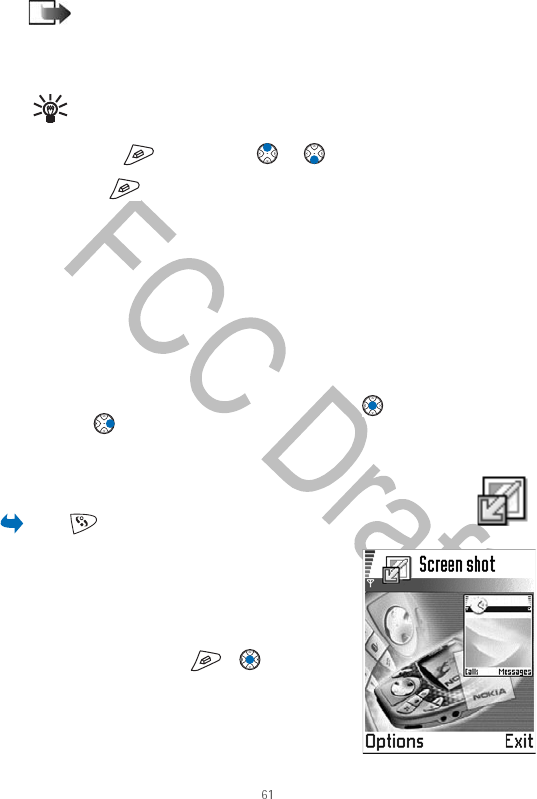
Nokia #### User Guide Copyright © Nokia 2003
Images and Screen shot
Note: When sending images, your device may display Message Sent. This
indicates the message has been sent to the message center number
programmed into your device. This does not indicate the message has
been received at the intended destination. For more details about
messaging services, check with your service provider.
Tip: You can send several images at a time using a Bluetooth connection.
To send several images at a time you need to mark them first. To mark
several images at a time, use the Options > Mark/Unmark commands, or
press and hold while pressing or . As the selection moves, a check
mark is placed next to the images. To end the selection, stop the controller key and
then release .
Picture messages folder
In the picture messages folder, you can find graphics sent to you in picture
messages.
Options in the picture messages folder are Open, Send, Delete, Mark/Unmark,
Rename, View details, Help, and Exit.
If you want to save a graphic you have received in a picture message, go to
Messaging > Inbox, open the message, and select Options > Save picture.
VIEW PICTURES
1Scroll to the picture you want to view and press .
2Press to view the next picture in the folder.
3Press Back to return to the main picture messages view.
• SCREEN SHOT
Press and go to Media > Screen shot.
The Screen shot application lets you capture images
from the screen of your game deck. You can then
send them to your friends in multimedia messages.
You can run Screen shot in the background so that
it disappears from the screen and is only activated
when you press a key combination that you assign
in Settings (the default is + ). See “Run in
the background” on page 62, and “Change settings”
on page 62.
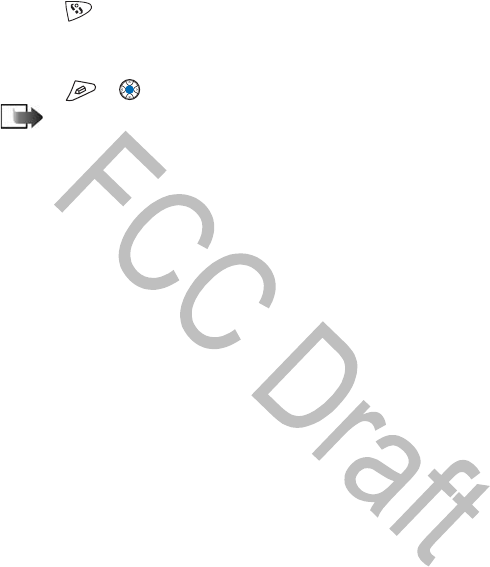
62 Copyright © Nokia 2003
Options in Screen shot are Keep app. active, Settings, Help, and “To continue
taking screen shots, select ‘Keep app. active’ instead of exiting. Exit now?”.
You can select one of three formats: Low JPG, High JPG or MBM?.
1Press and select Media > Screen shot.
2Select Options > Keep app. active.
Press Edit + control key to make a Screen Shot appears and the application
disappears from the screen.
3Press + to capture a screen.
Note: If memory is getting low, the game deck may close some
applications. The game deck saves any unsaved data before an application
is closed. See “Switch between applications” on page 7.
Run in the background
When you select Options > Keep app. active, the application disappears from the
screen. Screen shot is still active, has no effect on any application you want to run,
and lets you capture the screen contents anytime (for example, when you are
playing a game) by pressing a key combination that you assign in Settings. See
“Change settings” on page 62.
Change settings
Select Settings to open a list of Screen shot settings you can define.
Take scr. shot with—Select a key combination to activate Screen shot.
Folder name—Write a descriptive name for the folder where the screen shots are
saved.
Screen shot name—Write a descriptive name for the image.
Screen shot quality—Select one of three formats:
•Low JPG
• High JPG
•MBM?
Use default name—Select Yes if you want to save the image using the name you
entered in the Screen shot name option. Select No to set an individual name for
every image (the name you entered in the Screen shot name option appears by
default).
Options available are Take scr. shot with, Folder name, Screen shot name,
Screen shot quality, and Use default name.
You can save multiple images with the same image name (for example
“Screenshot”). The images are saved as “Screenshot,” “Screenshot(01),”
“Screenshot(02),” etc.
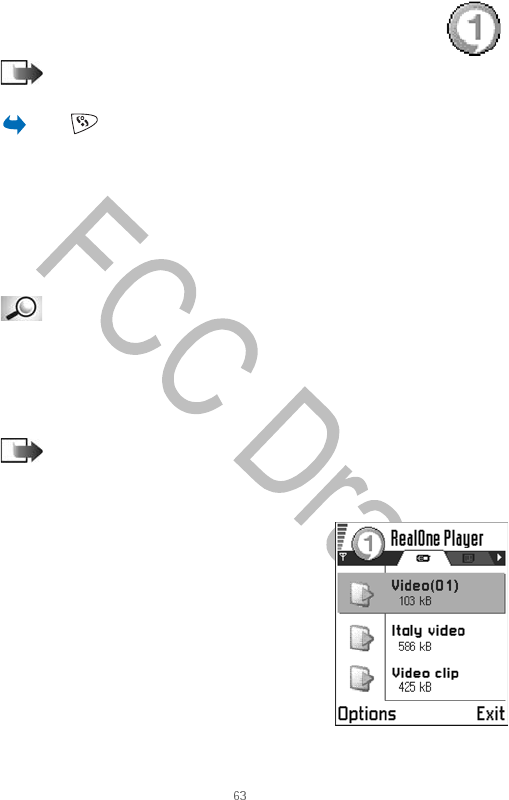
Nokia #### User Guide Copyright © Nokia 2003
RealOne Player™
9RealOne Player™
Note: Your game deck must be switched on to use this
function. Do not switch the game deck on when wireless device use is
prohibited or when it may cause interference or danger.
Press and go to Media > RealOne.
With the RealOne Player you can play media files stored in the game deck memory
or on a memory card, or play music and video files and stream live content from
the Internet.
Options in list view are Play, Open, Rename, Edit link (shown if a remote media
clip (link) is selected), Delete (shown if a local media clip is selected), New
folder, Move to folder, Mark/Unmark, Send, Add to favorites, Settings, About
product, Help and Exit.
Glossary: Media files are video, music or audio clips which you can play
on a media player like the RealOne Player. Files with extensions .3gp, .amr,
.rm, .ram, .ra and .rv. are supported by the RealOne Player.
RealOne Player uses shared memory. See “Shared memory” on page 12.
• PLAY MEDIA FILES
Note: You cannot connect to a site unless you have configured an access
point. See Default Access Point setting on page 65.
You can play any music or video file from the supported format list shown when
you start the RealOne Player or directly from the Internet.
•To play a media file stored in your game deck’s
memory or memory card, open RealOne Player,
scroll to the file and select Options > Play.
• To play a media file directly, or stream live
content from the Internet, select Options >
Open > URL address and enter the URL for the
desired Internet site.
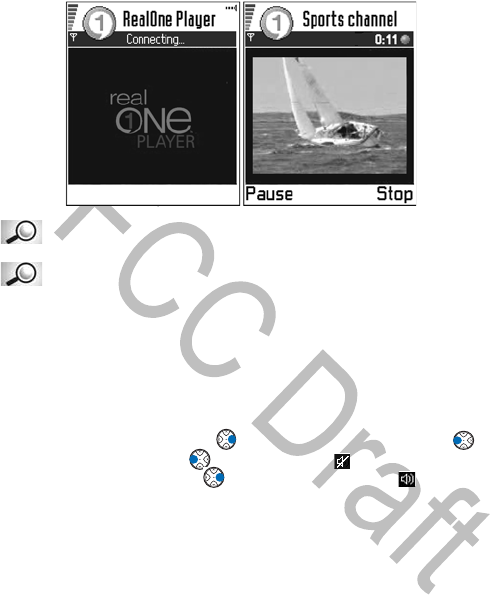
64 Copyright © Nokia 2003
Before your media file or stream begins playing, your game deck will connect to
the site and load the file.
Glossary: Streaming is playing sound or video in real time as it is
downloaded from the Internet, as opposed to storing it in a local file first.
Glossary: Buffering is the temporary storage of a part of your streaming
content into the game deck memory before it is played.
Media Guide
From your RealOne Player you can open a browser page containing a Media Guide
with links to streaming media sites and files.
To view the Media Guide, open RealOne Player and select Options > Open > Guide.
Volume control
• To increase the volume, press , or to decrease the volume, press .
• To mute the sound, press and hold until the indicator appears.
• To turn on the sound, press and hold until you see the indicator.
• SEND MEDIA FILES
You can send media files by using the Send option from your video clip list. This
feature requires related network service.
1Scroll to the file you want to send and select Options > Send.
2Select Via Bluetooth or Via multimedia to send the file.
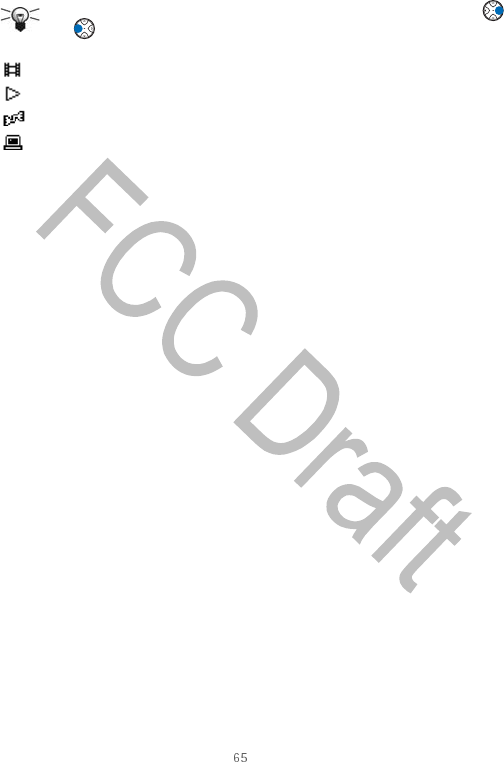
Nokia #### User Guide Copyright © Nokia 2003
RealOne Player™
• CHANGE THE SETTINGS
Tip: When you select one of the settings, a tab view is opened. Press
or to move between the different setting tabs. The following icons
indicate the setting:
Video
Playback
Network
Proxy
To change the Video settings, select Options > Video to open the following list of
settings:
Video quality—Choose Sharp images to have better picture quality, but slower
framerate, or High framerate for faster framerate, but lower picture quality.
Automatic scaling—Choose On to have automatic resizing of the video image.
To change the Playback settings, select Options > Playback to open the following
setting:
Repeat—Choose On to have the playing video or audio file restart automatically
once it has finished.
To change the Network settings, select Options > Network to open the following
list of settings:
Default Access Point—As defined in Connection settings, see “Access points” on
page 42.
Bandwidth—Choose Automatic to enable the best delivery rate available.
Maximum bandwidth—Choose the maximum bandwidth for streaming content.
Connection time-out—Open the slider view to change the waiting time for the
initial server connection on a streaming session.
Server time-out—Open the slider view to change the time allowed for no response
from the server.
Highest port and Lowest port—Enter the port numbers for streaming. If not you
are not sure of the numbers, contact your service provider.
To change the Proxy settings, select Options > Proxy to open the following list of
settings:
Use Proxy, Host address, Port—Choose whether a proxy is used.
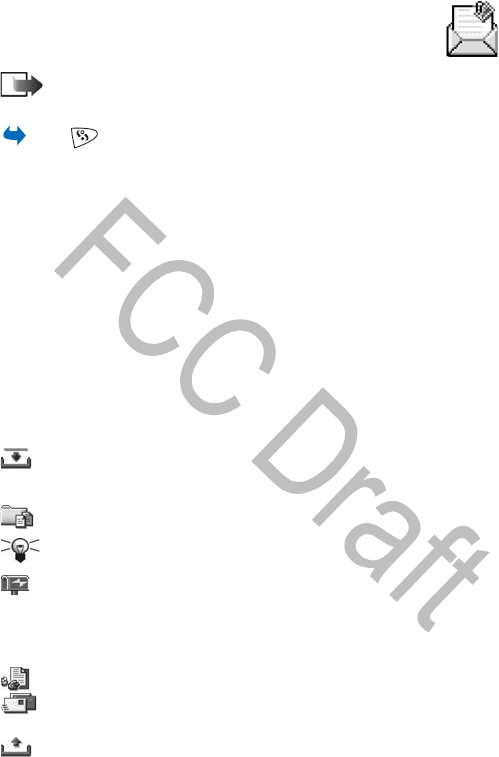
66 Copyright © Nokia 2003
10 Messaging
Note: Your game deck must be switched on to use the functions in the
Messaging folder. Do not switch the game deck on when wireless device
use is prohibited or when it may cause interference or danger.
Press and go to Messaging.
In Messaging you can create, send, receive, view, edit, and organize text messages,
multimedia messages, e-mail messages, and smart messages (special text
messages containing data).
In addition to these, you can receive messages and data using a Bluetooth
connection, receive WAP service messages, and cell broadcast messages and send
service commands.
Options in the Messaging main view are Create message, Connect (shown if
you have defined settings for the mailbox), or Disconnect (shown if there is an
active connection to mailbox), SIM messages, Cell broadcast, Service command,
Settings, Help, and Exit.
Text and multimedia messages use shared memory. See “Shared memory” on
page 12.
When you open Messaging, you can see the Create message function and a list of
default folders:
Inbox—contains received messages except e-mail and cell broadcast
messages. E-mail messages are stored in the Mailbox. You can read cell broadcast
messages by selecting Options > Cell broadcast.
My folders—for organizing your messages into folders.
Tip: Organize your messages by adding new folders under My folders.
Mailbox—When you open this folder, you can either connect to your remote
mailbox to retrieve your new e-mail messages or view your previously retrieved
e-mail messages offline. See page 81 for further information on online and offline
modes. After you have defined settings for a new mailbox, the name given to that
mailbox will replace Mailbox in the main view. See “E-mail settings” on page 89.
Drafts—stores draft messages that have not been sent.
Sent—stores the last 20 messages that have been sent. To change the
number of messages to be saved, see “Other folder settings” on page 91.
Outbox—is a temporary storage place for messages waiting to be sent.
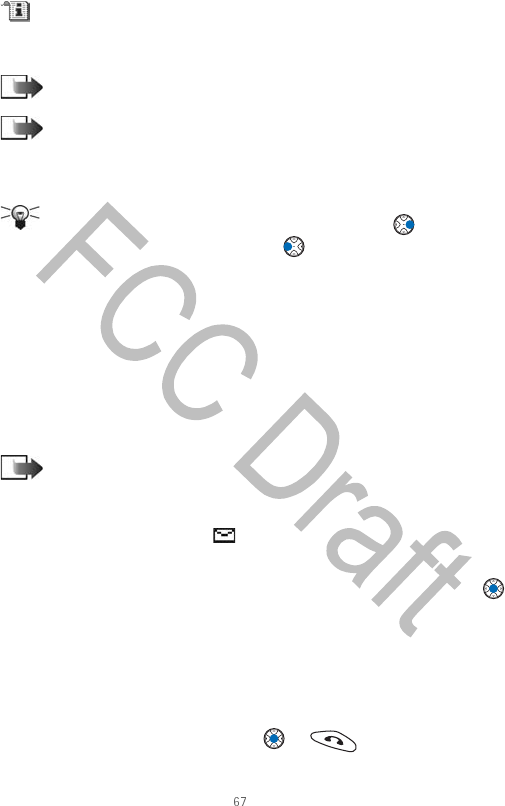
Nokia #### User Guide Copyright © Nokia 2003
Messaging
Reports- you can request the network to send you a delivery report of the
text messages, smart messages, and multimedia messages you have sent. To turn
on delivery report reception, select Options > Settings > Text message, scroll to
Receive report, and select Yes.
Note: Receiving a delivery report of a multimedia message that has been
sent to an e-mail address might not be possible.
Note: Before you can create a multimedia message, write an e-mail, or
connect to your remote mailbox, you must have the correct connection settings in
place. See “E-mail settings” on page 89, and “Multimedia messages settings” on
page 87.
Tip: When you have opened one of the default folders, for example, Sent,
you can easily move between the folders: by pressing to open the
next folder (Outbox), or by pressing to open the previous folder
(Drafts).
• GENERAL MESSAGE INFORMATION
The message status is always either draft, sent, or received. Messages can be saved
to the Drafts folder before they are sent. Messages are temporarily placed to
Outbox to wait for sending. After a message has been sent, you can find a copy of
the message in the Sent folder. Received and sent messages are in read-only state
until you select Reply or Forward, which copies the message to an editor. Note that
you cannot forward e-mail messages you yourself have sent.
Note: Messages or data that sent using a Bluetooth connection are not
saved in the Draft or Sent folders.
Open a received message
• When you receive a message, and 1 new message appears in the standby
mode, press Show to open the message.
• If you have more than one new message, press Show to open the Inbox to see
the message headings. To open a message in Inbox, scroll to it and press .
Add a recipient
When you create a message, there are several ways to add a recipient. You can
write the phone number or e-mail address of the recipient in the To: field, or copy
the recipient information from another application and then paste it to the To:
field. See “Copy text” on page 71. Also, you can enter a recipient from the Contacts
directory:
1To open the Contacts directory, press or in the To: or Cc: fields,
or select Options > Add recipient.
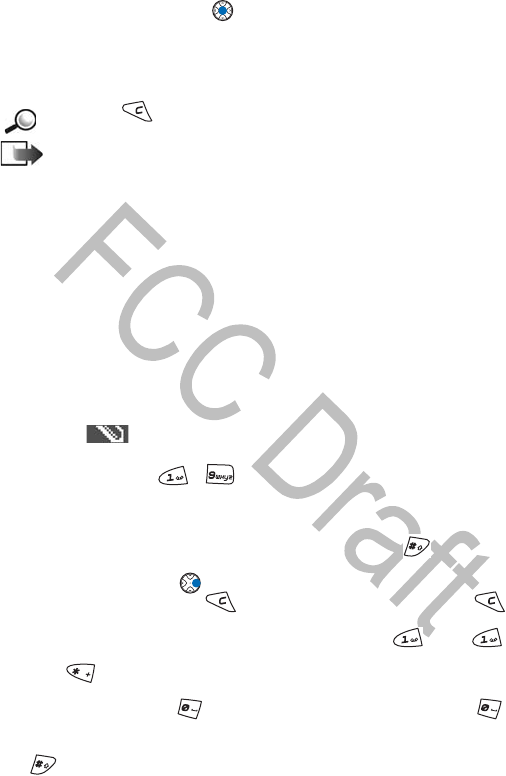
68 Copyright © Nokia 2003
2Scroll to a contact and press to mark it.
You can mark several recipients at a time.
3Press OK to return to the message.
The recipients are listed in the To: field and automatically separated with a
semicolon (;).
Tip: Press to delete a recipient to the left of the cursor.
Note: If you write many phone numbers or e-mail addresses in the To:
field, you must remember to add a semicolon (;) between each item to
separate them from each other. When you retrieve recipients from the
Contacts directory, the semicolon is added automatically.
Sending options
To change how a message is sent, select Options > Sending options when you are
editing a message. When you save the message, its sending settings are also saved.
• WRITE TEXT
You can enter text in two different ways. You can use the method traditionally used
in mobile devices or you can use an advanced method called predictive text input.
Use traditional text input
The indicator appears on the top right of the display when you are writing
text using traditional text input.
• Press a number key ( —) repeatedly until the desired character
appears. Note, that there are more characters available for a number key than
are printed on the key.
• To insert a number, press and hold the number key.
• To switch between letter and number mode, press and hold .
• If the next letter is located on the same key as the present one, wait until the
cursor appears (or press to end the time-out period), and key in the letter.
• If you make a mistake, press to remove a character. Press and hold
to clear more than one character.
• The most common punctuation marks are available under . Press
repeatedly to reach the desired punctuation mark.
Press to open a list of special characters. Use the controller key to move
through the list and press OK to select a character.
• To insert a space, press . To move the cursor to the next line, press
three times.
• To switch between the different character cases, Abc, abc, and ABC, press
.
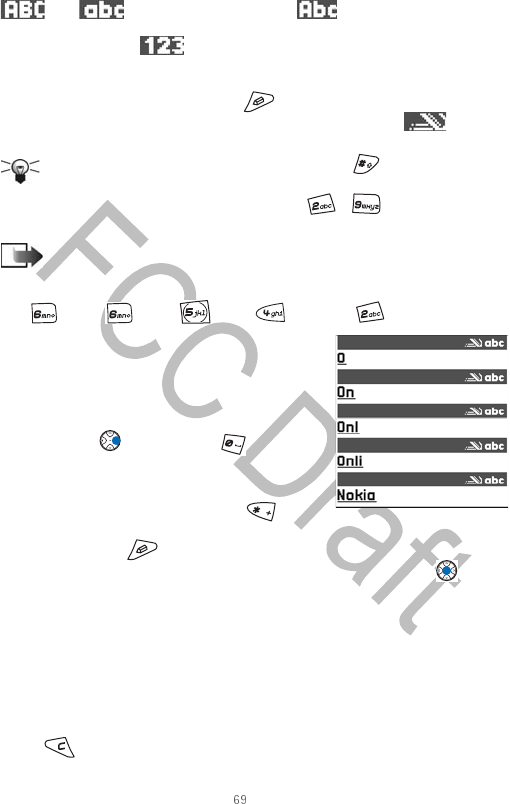
Nokia #### User Guide Copyright © Nokia 2003
Messaging
and indicate the selected case. means that the first letter
of the word, is written in upper case, and all the other letters will automatically be
written in lower case. indicates number mode.
Use predictive text input
To activate predictive text input, press and select Dictionary on. This will
activate predictive text input for all editors in the game deck. The indicator
appears at the top of the display.
Tip: To set predictive text input on or off, press twice quickly when
writing text.
1Write the desired word by pressing the keys —.
Press each key only once for one letter. The word changes after every key press.
Note: The word match evolve as you add new letters, so wait until you
have keyed in the whole word before you check the result.
For example, to write “Nokia” when English dictionary is selected, press
for N, for o, for k, for i, and for a.
As you can see, the word suggestion changes
after each key press.
2When you have finished the word, check that it
is correct.
• If the word is correct, you can confirm it by
pressing or by pressing to insert a
space. The underlining disappears and you
can begin to write a new word.
• If the word is not correct, press
repeatedly to view the matching words the dictionary has found one by
one, or press and select Dictionary > Matches to view a list of
matching words. Scroll to the word you want to use and press to
select it.
•If ? appears after the word, the word you intended to write is not in the
dictionary. To add a word to the dictionary, press Spell, key in the word (up
to 32 letters) using traditional text input, and press Save. The word is
added to the dictionary. When the dictionary becomes full, a new word
replaces the oldest added word.
•To remove the ? and clear characters one by one from the word, press
.
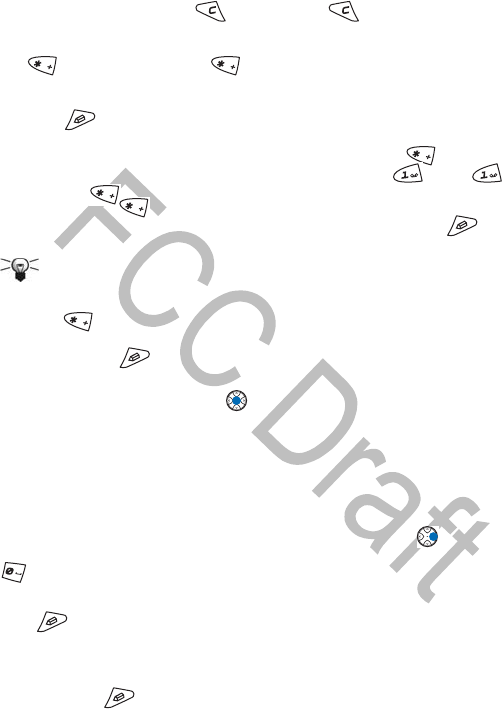
70 Copyright © Nokia 2003
Predictive text input tips
• To erase a character, press . Press and hold to clear more than one
character.
• To change between the different character cases Abc, abc, and ABC, press
. Note that if you press quickly twice the predictive text input is
turned off.
• To insert a number in letter mode, press and hold the desired number key, or
press and select Insert number. Key in the numbers you want, and press
OK.
• To switch between letter and number mode, press and hold .
• The most common punctuation marks are available under . Press
and then repeatedly to reach the desired punctuation mark.
• Press and hold to open a list of special characters. Use the controller key
to scroll through the list and press OK to select a character. Or press and
select Insert symbol.
Tip: The predictive text input will try to guess which commonly used
punctuation mark (.,?!‘) is needed. The order and availability of the
punctuation marks depend on the language of the dictionary.
• Press repeatedly to view the matching words the dictionary has found
one by one.
You can also press , select Dictionary and select
•Matches—to view a list of words that correspond to your key presses. Scroll to
the desired word and press the .
•Insert word—to add a word (max. 32 letters) to the dictionary by using
traditional text input. When the dictionary becomes full, a new word replaces
the oldest added word.
•Edit word—to open a view where you can edit the word, available only if the
word is active (underlined).
WRITE COMPOUND WORDS
Write the first half of a compound word and confirm it by pressing . Write the
last part of the compound word and complete the compound word by pressing
to add a space.
TURN PREDICTIVE TEXT INPUT OFF
Press and select Dictionary > Off to turn predictive text input off for all
editors in the game deck.
Edit options
When you press , the following options appear (depending on the editing
mode and situation you are in):
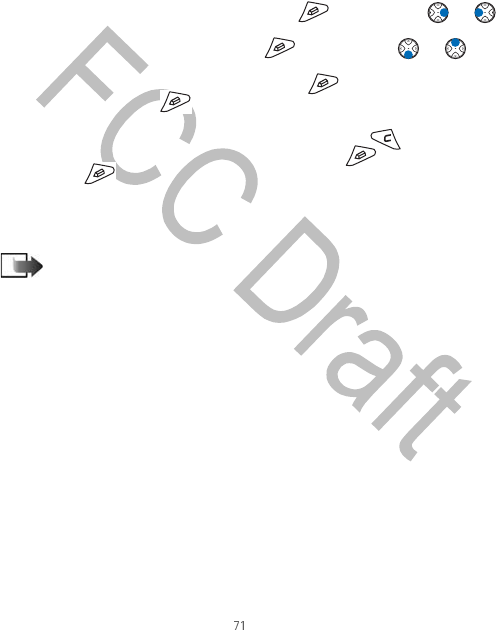
Nokia #### User Guide Copyright © Nokia 2003
Messaging
•Dictionary (predictive text input), Alpha mode (traditional text input),
Number mode
•Cut, Copy—available only if text has been selected first
•Paste—available only when text has been either cut or copied to the clipboard
•Insert number and Insert symbol
•Writing language (changes the input language for all editors in the game
deck. See “Device settings” on page 37.)
COPY TEXT
To work with text in the clipboard, use the following methods:
• To select letters and words, press and hold while pressing or .
As the selection moves, text is highlighted.
• To select lines of text, press and hold while pressing or .
• To end the selection, release the controller key.
• To copy the text to clipboard press and hold and press Copy.
You can also release and then press it once to open a list of editing
commands, for example, Copy or Cut.
• To remove the selected text from the document, press .
• To insert the text into a document, press and hold and press Paste.
Or press once and select Paste.
• CREATE AND SEND NEW MESSAGES
Note: When sending messages, your game deck may display Sent. This is
an indication that the message has been sent by your game deck to the
message center number programed into your game deck. This is not an
indication that the message has been received at the intended
destination. For more details about messaging services, check with your
service provider.
You can start to create a message in two ways:
• Selecting New message > Create: Text message, Multimedia message, or
E-mail in Messaging.
• Start to create a message from an application that has the option Send. In this
case the file that was selected (such as an image or text) is added to the
message
Write and send text messages
1Select New message.
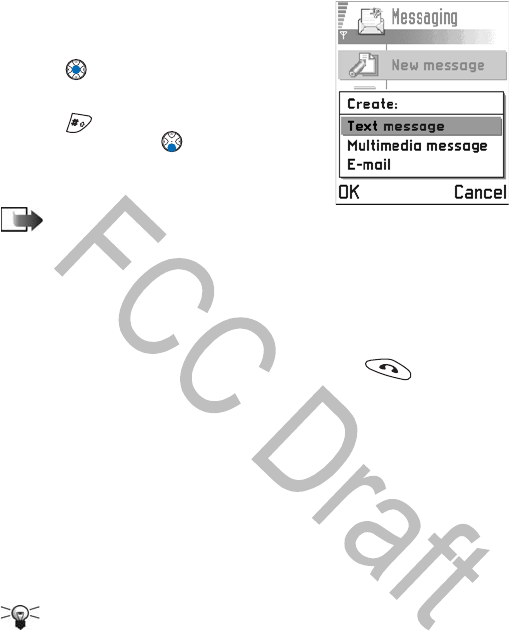
72 Copyright © Nokia 2003
A list of message options opens.
2Select Create: Text message.
The editor opens with the cursor in the To: field.
3Press to select recipients from the
Contacts directory or write the phone number
of the recipient.
Press to add a semicolon (;) to separate
each recipient. Press to move to the
message field.
4Write the message.
Note: Your game deck supports sending
multiple text messages at the same time. Therefore, the normal 160-
character limit for one text message can be exceeded. If your text exceeds
160 characters, it will be sent in two or more messages and message
sending may cost more.
In the navigation bar, you can see the message length indicator counting
backwards from 160. For example, 10 (2) means that you can still add 10
characters for the text to be sent as two messages.
5To send the message, select Options > Send or press .
Options in the text message editor are Send, Add recipient, Insert, Delete,
Message details, Sending options, Help, and Exit.
Send smart messages
Smart messages are special text messages that can contain data. You can send the
following smart messages:
•Picture messages
• Business cards containing contact information in generic (vCard) format
• Calendar notes (vCalendar format)
For more information, see “Send contact information” on page 56, “Send calendar
entries” on page 99, and “Send bookmarks” on page 108.
Tip: You can also receive ringing tones, operator logos, or settings from
service providers. See page 79.
Create and send picture messages
Options in the picture message editor are Send, Remove picture, Add recipient,
Delete, Insert, Message details, Help, and Exit.
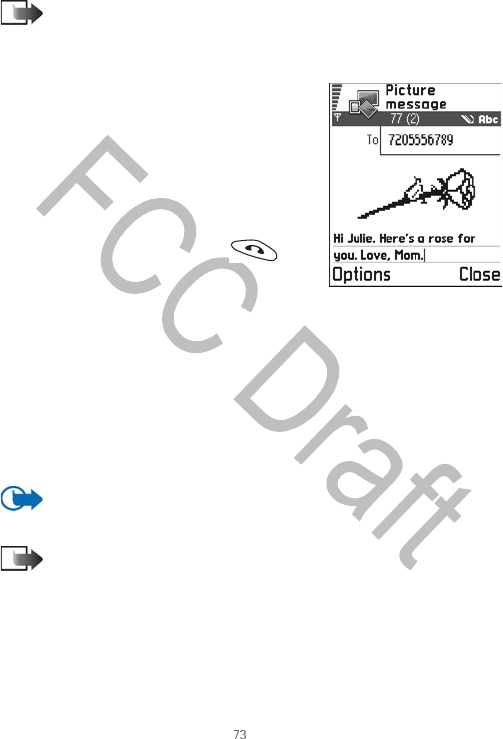
Nokia #### User Guide Copyright © Nokia 2003
Messaging
Your game deck allows you to send and receive picture messages. Picture messages
are text messages that contain small black-and-white graphics. There are several
default pictures available in the Picture msgs. folder in Media > Images.
Note: This function can be used only if it is supported by your network
operator or service provider. Only devices that offer picture message
features can receive and display picture messages.
To send a picture message, perform the following steps:
1Do one of the following:
Go to Media > Images > Picture msgs. and
select a picture to be sent. Select Options >
Send.
OR
Select Messaging > New message > Create:
Text message and select Insert > Picture.
2Enter recipient information and add text.
3Select Options > Send or press .
Each picture message is made up of several
text messages. Therefore, sending one picture
message may cost more than sending one text
message.
Multimedia messages
A multimedia message can contain a combination of text and video clips, or text,
images and sound clips, but never a combination of images and video clips.
Options in the multimedia message editor are Send, Add recipient, Insert,
Preview message, Remove, Objects, Delete, Message details, Sending options,
Help, and Exit.
Important: Copyright protections may prevent some images, ringing
tones and other content from being copied, modified, transferred, or
forwarded.
Note: This function can be used only if it is supported by your network
operator or service provider. Only devices that offer compatible
multimedia message or e-mail features can receive and display
multimedia messages. Devices that do not have these features may
receive details of a link to a web page.
SETTINGS
You may receive the settings as a smart message from your network operator or
service provider. See “Receive smart messages” on page 79.

74 Copyright © Nokia 2003
For availability of and subscription to data services, please contact your network
operator or service provider.
1Go to Settings > Connection settings > Access points and define the settings
for a multimedia messaging access point:
Connection name—Give a descriptive name for the connection.
Session mode—Select a data connection type: GSM data, High speed GSM,
or GPRS.
Gateway IP address—enter the address.
Homepage—enter the address of the multimedia messaging center.
Domain names such as www.NokiaUSA.com can be translated into IP
addresses like 192.100.124.195.
2If you selected GSM data or High speed GSM, fill in Dial-up number—a phone
number for the data call.
3If you selected GPRS, fill in: Access point name—the name given by your
service provider.
For further information on different data connections, see also “Connection
settings” on page 40.
4Go to Messaging > Options > Settings > Multimedia message.
5Open Preferred connection and select the access point you created to be used
as the preferred connection. See also “Multimedia messages settings” on
page 87.
SET UP MEMORY
The memory in use defines whether the game deck memory or the memory card are
used as default. To define the memory in use, go to Messaging > Options >
Settings > Other Memory in use, and select either the game deck’s memory or the
memory card.
CREATE MULTIMEDIA MESSAGES
When you send a multimedia message to a compatible device other than a Nokia
N-Gage game deck, use a smaller image size and a sound clip that is no longer than
15 seconds. The default setting is Image size: Small. If you want to check the image
size setting, go to Messaging > Options > Settings > Multimedia message or
select Options > Sending options when you are creating a multimedia message.
When you are sending a multimedia message to an e-mail address or another Nokia
N-Gage game deck, if possible, use the larger image size (network dependent). To
change the setting, select Options > Sending options > Image size > Large when
you are creating a multimedia message.
1In Messaging, select New message > Create: Multimedia message and press
.
2Press to select the recipients from the Contacts directory or write the
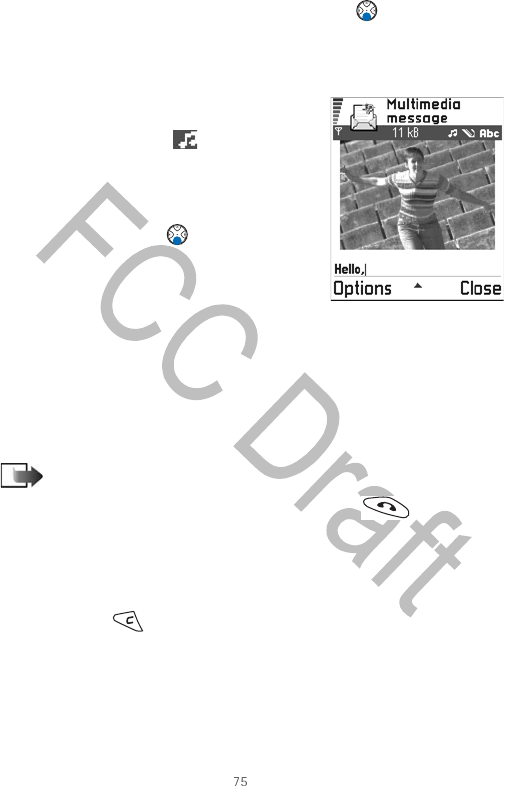
Nokia #### User Guide Copyright © Nokia 2003
Messaging
phone number or e-mail address of the recipient in the To: field.
3Add a semicolon (;) to separate each recipient. Press to move to the next
field.
4You can add the different objects of the multimedia message in any order.
• To add an image, select Options > Insert > Image.
• To add a sound, select Options > Insert >
Sound clip or New sound clip. When sound
has been added, the icon appears in
the navigation bar.
• To add video, select Options > Insert >
Video clip.
• To write text, press .
• If you select Insert > Image, Sound clip,
Video clip, or Template, a list of items
opens. Scroll to the item you wish to add
and press Select.
• If you chose Image, you must first select whether the image is stored—in
the game deck memory or the memory card.
• If you select Insert > New sound clip, Recorder opens and you can record
a new sound. The new image or sound is automatically saved and a copy is
inserted in the message.
Note: A multimedia message can contain only one image and one sound
clip.
5To send the message, select Options > Send or press .
PREVIEW A MULTIMEDIA MESSAGE
To see how a multimedia message will appear, select Options > Preview message.
REMOVE AN OBJECT
To remove a multimedia object, select Options > Remove > Image Video clip or
Sound clip. Press to remove text.
WORK WITH MEDIA OBJECTS
To see all the different media objects included in a multimedia message, open a
multimedia message and select Options > Objects to open the Objects view.
Options in the Objects view are Open, Insert, Place image first / Place text first,
Remove, Help, and Exit.
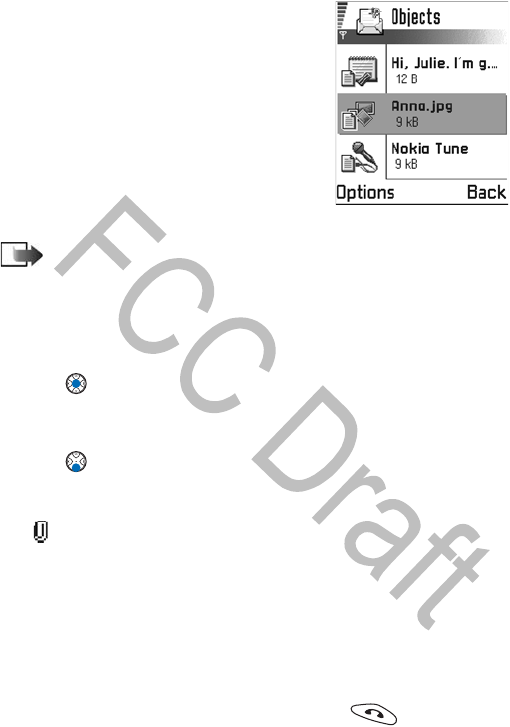
76 Copyright © Nokia 2003
In the Objects view, you can change the order of the
different objects, delete objects, or open an object in
a corresponding application.
You can see a list of different objects and their file
sizes.
E-MAIL
Before you can send, receive, retrieve, reply to, and
forward e-mail, you must do the following:
• Configure an Internet Access Point (IAP)
correctly. See “Connection settings” on
page 40.
• Define your e-mail settings correctly. See “E-mail settings” on page 89.
Note: Follow the instructions given by your remote mailbox and ISP.
Use the following procedure to write and send e-mail messages:
Options in the e-mail editor are Send, Add recipient, Insert, Attachments,
Delete, Message details, Sending options, Help, and Exit.
1Select New message > Create: E-mail.
The editor opens.
2Press to select the recipients from the Contacts directory or write the
e-mail address of the recipient in the To: field.
Add a semicolon (;) to separate each recipient. If you want to send a copy of
your e-mail to someone, write the address in the Cc: field.
3Press to move to the next field.
4Write the message.
5To add an attachment to the e-mail, select Options > Insert > Image, Sound
clip, Video clip or Note.
appears in the navigation bar to indicate the e-mail has an attachment.
Template adds prewritten text to the e-mail.
You can also add an attachment to an e-mail by selecting Options >
Attachments in an open e-mail. The Attachments view opens so you can add,
view, and remove attachments.
If you chose Image, you must first indicate whether the image is stored—in the
phone’s memory or the memory card.
6To remove an attachment, scroll to the attachment and select Options >
Remove.
7To send the e-mail, select Options > Send or press .
E-mail messages are automatically placed in Outbox before sending. If
something goes wrong while the game deck is sending the e-mail, the e-mail
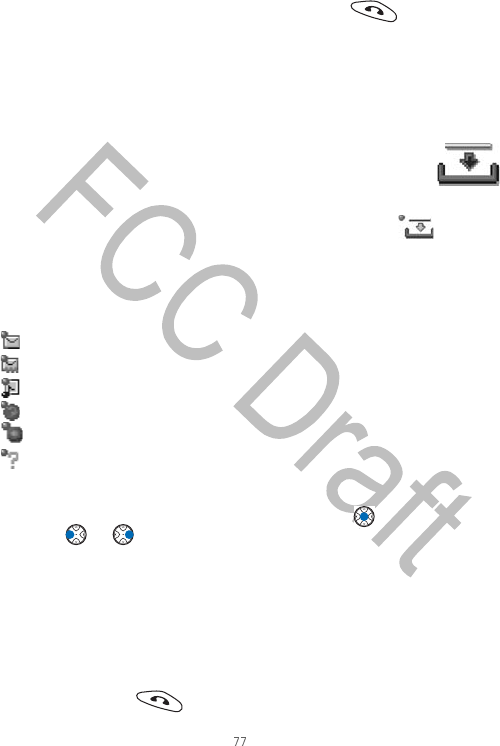
Nokia #### User Guide Copyright © Nokia 2003
Messaging
is left in the Outbox with the status Failed.
8To send files other than sounds and notes as attachments, open the
appropriate application and select the option Send > Via e-mail, if available.
9To send the e-mail, select Options > Send or press .
E-mail messages are automatically placed in Outbox before sending. If
something goes wrong while the game deck is sending the e-mail, the e-mail
is left in the Outbox with the status Failed.
10 To send files other than sounds and notes as attachments, open the
appropriate application and select the option Send > Via e-mail, if available.
• INBOX—RECEIVE MESSAGES
Messages and data can be received using text message or
multimedia service using a Bluetooth wireless connection from compatible devices.
When there are unread messages in Inbox, the icon changes to .
Options in Inbox are Open, Create message, Delete, Message details, Move to
folder, Mark/Unmark, Help, and Exit.
In Inbox, the message icons tell you what kind of a message it is. Here are some of
the icons that you may see:
An unread text message
An unread smart message
An unread multimedia message
An unread WAP service message
Data received using a Bluetooth wireless connection
An unknown message type
View messages in Inbox
1To open a message, scroll to the message and press .
2Press or to move to the previous or next message in the folder.
Message view options
The available options depend on the type of message you have opened for viewing:
Save picture—saves the picture to Media > Images > Picture msgs.
Reply—copies the address of the sender to the To: field. Select Reply > To all to
copy the address of the sender and Cc. field recipients to the new message.
Forward—copies the message contents to an editor.
Call—call by pressing .
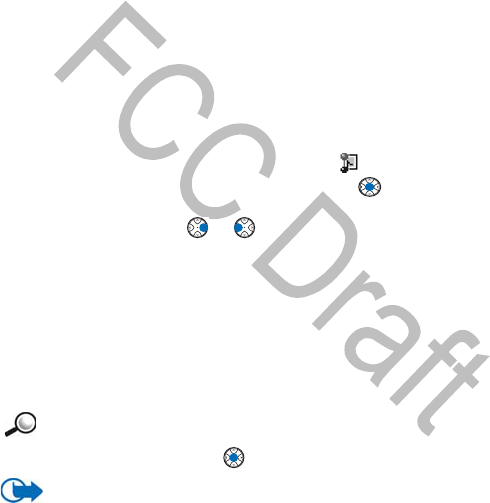
78 Copyright © Nokia 2003
View image—allows you to view and save the image.
Play sound clip—allows you to listen to the sound in the message.
Objects—shows you a list of all the different multimedia objects in a multimedia
message.
Attachments—shows you a list of files sent as e-mail attachments.
Message details—shows detailed information about a message.
Move to folder / Copy to folder—allows you to move or copy messages to My
folders, Inbox, or other folders you have created. For more information on using
folders, see “Application Actions” on page 8.
Add to Contacts—allows you to copy the phone number or e-mail address of the
message sender to the Contacts directory. Choose whether you want to create a
new contact card or add the information to an existing contact card.
Find—Searches the message for phone numbers, e-mail addresses, and Internet
addresses. After the search, you can make a call or send a message to the found
number or e-mail address, or save the data to Contacts or as a browser bookmark.
View multimedia messages in Inbox
You can recognize multimedia messages by their icon :
1To open a multimedia message, scroll to it and press .
You can see an image, read a message, and hear a sound simultaneously.
2If sound is playing, press or to increase or decrease the volume.
3To mute the sound, press Stop.
MULTIMEDIA MESSAGE OBJECTS
Options in the Objects view are Open, Save, Send, Help, and Exit.
To see what kinds of media objects have been included in the multimedia message,
open the message and select Options > Objects. In the Objects view you can view
files that have been included in the multimedia message. You can choose to save
the file in your game deck or to send it, for example, using wireless technology to
another device.
Tip: You can open a vCard file and save the contact information in the file
to Contacts.
To open a file, scroll to it and press .
Important: Multimedia message objects may contain viruses or
otherwise be harmful to your game deck or PC. Do not open any
attachment if you are not sure of the trustworthiness of the sender. For
more information, see “Certificate management” on page 48.
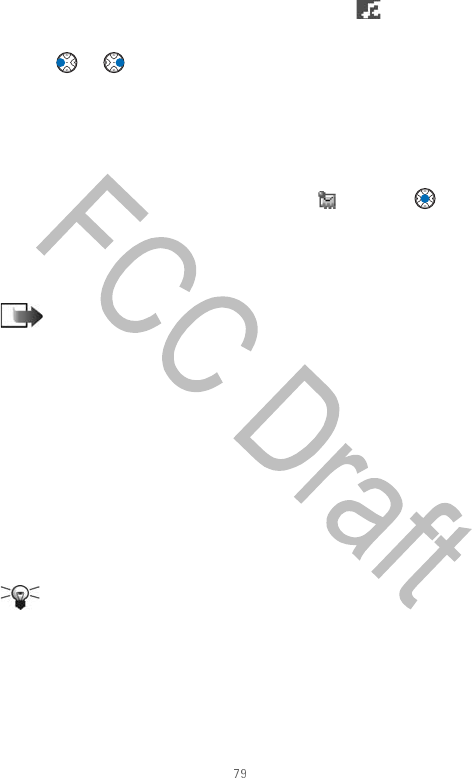
Nokia #### User Guide Copyright © Nokia 2003
Messaging
SOUNDS IN A MULTIMEDIA MESSAGE
Sound objects in a multimedia message are indicated by indicator in the
navigation bar. Sounds are by default played through the loudspeaker. To stop the
sound, press Stop while the sound is playing. You can change the volume level by
pressing or .
If you want to listen to a sound again after all the objects have been shown and
the playing of the sound has stopped, select Options > Play sound clip.
Receive smart messages
Your game deck can receive many kinds of smart messages — text messages that
contain data (also called Over-The-Air (OTA) messages). To open a received smart
message, open Inbox, scroll to the smart message ( ), and press .
Picture message—to save the picture in the Picture msgs. folder in Media >
Images for later use, select Options > Save picture.
Business card—to save the contact information, select Options > Save business
card.
Note: If certificates or sound files are attached to business cards, they
will not be saved.
Ringing tone—to save the ringing tone to Composer, select Options > Save.
Operator logo—to save the logo, select Options > Save. The operator logo can now
be seen in the standby mode instead of the network operator’s own identification.
Calendar entry—to save the invitation to Calendar, select Options > Save to
Calendar.
WAP message—to save the bookmark, select Options > Save to bookmarks. The
bookmark is added to the Bookmarks list in browser service. If the message
contains both browser access point settings and bookmarks, select Options > Save
all to save the data. Or, select Options > View details to view the bookmark and
access point information separately. If you do not want to save all data, select a
setting or bookmark, open the details and select Options > Save to settings or
Save to bookmarks depending on what you are viewing.
Tip: To change the default access point settings for WAP or multimedia
messaging, go to Services > Options > Settings > Default access point
or Messaging > Options > Settings > Multimedia message > Preferred
connection.
E-mail notification—Tells you how many new e-mails you have in your remote
mailbox. An extended notification may list more detailed information such as
subject, sender, attachments, and so on. In addition, you can receive a text message
service number, voice mailbox number, profile settings for remote synchronization,
access point settings for the browser, multimedia messaging or e-mail, access point
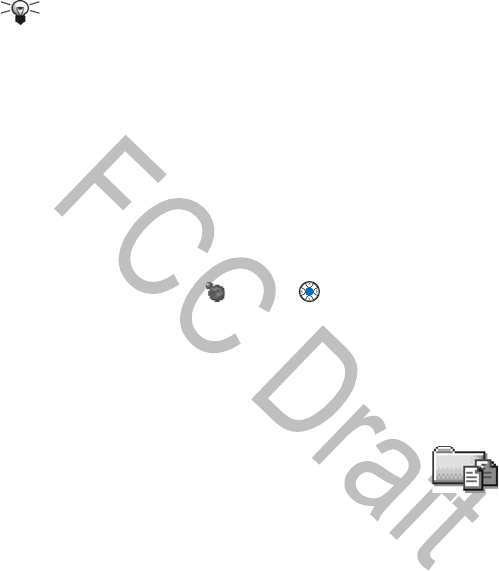
80 Copyright © Nokia 2003
login script settings, or e-mail settings. To save the settings, select Options > Save
to SMS sett., Save to Voice mail, Save to settings, Save to settings (checkthis/
cl), or Save to e-mail sett..
Tip: If you receive a vCard file with a picture attached, the picture will be
saved to Contacts as well.
Service messages
Service messages are sent by your provider and are notifications of, for example,
news headlines. They may contain a text message or address of a browser service.
For availability and subscription, contact your service provider.
Service providers can update an existing service message every time a new service
message is received. Messages can be updated even if you have moved them from
Inbox to another folder. When service messages expire, they are deleted
automatically.
Options when viewing a service message are Download message, Move to
folder, Message details, Help, and Exit.
VIEW SERVICE MESSAGES
1Scroll to a service message ( ) and press .
2To download or view the message, press Download message. The game deck
starts to make a data connection, if needed.
3Press Back to return to Inbox.
VIEW SERVICE MESSAGES IN BROWSER
When you are browsing, select Options > Read service msgs. to download and
view new service messages.
• MY FOLDERS
Options in My folders are Open, New message, Delete, Message
details, Move to folder, New folder, Rename, Help, and Exit.
In My folders you can organize your messages into folders, create new folders, and
rename and delete folders. Select Options > Move to folder, New folder, or
Rename folder. For more information, see “Move items to a folder” on page 9.
You can use text templates to avoid rewriting messages that you send often. To
create a new template, select Options > New template.
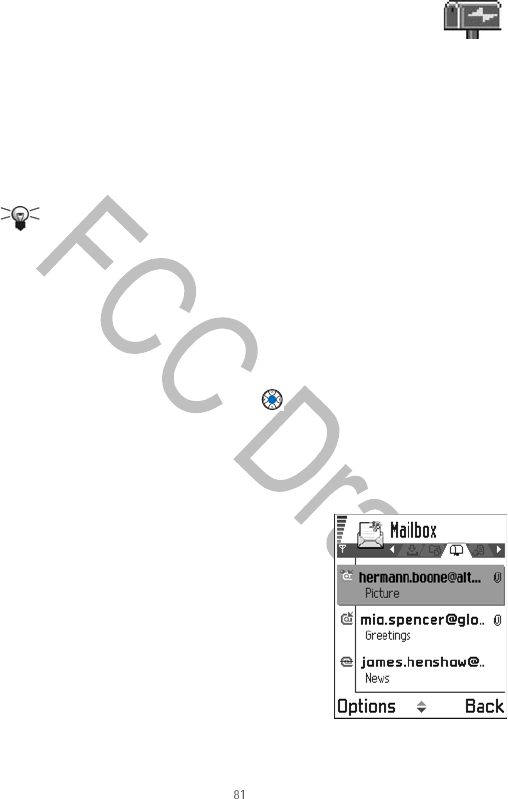
Nokia #### User Guide Copyright © Nokia 2003
Messaging
•REMOTE MAILBOX
When you open this folder, you can connect to your remote mailbox
to retrieve new e-mail headings or messages, or to view your previously retrieved
e-mail headings or messages offline.
If you select New message > Create: E-mail or Mailbox in Messaging and you
have not set up your e-mail account, you will be prompted to do so. See “E-mail
settings” on page 89.
When you create a new mailbox, the name you give to the mailbox automatically
replaces Mailbox in Messaging. You can have up to six mailboxes.
Tip: The Settings wizard program included in the PC Suite for the Nokia
N-Gage game deck can help you configure access point and mailbox
settings. You can also copy existing settings, for example, from your
computer to your game deck. See the CD-ROM supplied in the sales
package.
Open the mailbox
When you open the mailbox, you can choose whether you want to view the
previously retrieved e-mail messages and e-mail headings offline or connect to the
e-mail server.
When you scroll to your mailbox and press , the game deck asks you if you want
to Connect to mailbox? Select Yes to connect to your mailbox or No to view
previously retrieved e-mail messages offline.
Another way to start a connection is to select Options > Connect.
View e-mail messages when online
When you are viewing messages online, you are
continuously connected to a remote mailbox using
a data call or a packet data connection. See also
“Data connection indicators” on page 6, “GSM data
calls verify all settings” on page 41, and “Packet
data (GPRS)” on page 41.
Options when viewing e-mail headings are Open,
New message, Connect / Disconnect, Retrieve,
Delete, Message details, Copy, Mark/Unmark,
Help, and Exit.